ZyXEL Communications MAX200M1 WiMAX IEEE802.16e Indoor Basic CPE-2.5GHz User Manual ZyBook
ZyXEL Communications Corporation WiMAX IEEE802.16e Indoor Basic CPE-2.5GHz ZyBook
Contents
- 1. User manual1
- 2. User manual2
- 3. User manual3
- 4. User manual4
User manual1

MAX-200M1 Series
IEEE 802.16e Simple Indoor CPE
User’s Guide
Version 3.60
04/2007
Edition 1

ZyXEL MAX-200M1 Series User’s Guide
Copyright 3
Copyright
Copyright © 2007 by ZyXEL Communications Corporation.
The contents of this publication may not be reproduced in any part or as a whole, transcribed,
stored in a retrieval system, translated into any language, or transmitted in any form or by any
means, electronic, mechanical, magnetic, optical, chemical, photocopying, manual, or
otherwise, without the prior written permission of ZyXEL Communications Corporation.
Published by ZyXEL Communications Corporation. All rights reserved.
Disclaimer
ZyXEL does not assume any liability arising out of the application or use of any products, or
software described herein. Neither does it convey any license under its patent rights nor the
patent rights of others. ZyXEL further reserves the right to make changes in any products
described herein without notice. This publication is subject to change without notice.
Trademarks
ZyNOS (ZyXEL Network Operating System) is a registered trademark of ZyXEL
Communications, Inc. Other trademarks mentioned in this publication are used for
identification purposes only and may be properties of their respective owners.

ZyXEL MAX-200M1 Series User’s Guide
4Certifications
Certifications
Federal Communications Commission (FCC) Interference Statement
The device complies with Part 15 of FCC rules. Operation is subject to the following two
conditions:
• This device may not cause harmful interference.
• This device must accept any interference received, including interference that may cause
undesired operations.
This device has been tested and found to comply with the limits for a Class B digital device
pursuant to Part 15 of the FCC Rules. These limits are designed to provide reasonable
protection against harmful interference in a residential installation. This device generates,
uses, and can radiate radio frequency energy, and if not installed and used in accordance with
the instructions, may cause harmful interference to radio communications. However, there is
no guarantee that interference will not occur in a particular installation.
If this device does cause harmful interference to radio/television reception, which can be
determined by turning the device off and on, the user is encouraged to try to correct the
interference by one or more of the following measures:
1Reorient or relocate the receiving antenna.
2Increase the separation between the equipment and the receiver.
3Connect the equipment into an outlet on a circuit different from that to which the receiver
is connected.
4Consult the dealer or an experienced radio/TV technician for help.
FCC Radiation Exposure Statement
• The device complies with FCC RF radiation exposure limits set forth for an uncontrolled
environment, under 47 CFR 2.1093 paragraph (d)(2). End users must follow the specific
operating instructions for satisfying RF exposure compliance. To maintain compliance
with FCC RF exposure compliance requirements, please follow operation instruction as
documented in this manual.
• This transmitter must not be co-located or operating in conjunction with any other
antenna or transmitter.
• To comply with FCC RF exposure compliance requirements, a separation distance of at
least 20 cm must be maintained between the antenna of this device and all persons.
注意 !
依據 低功率電波輻射性電機管理辦法
第十二條 經型式認證合格之低功率射頻電機,非經許可,公司、商號或使用
者均不得擅自變更頻率、加大功率或變更原設計之特性及功能。

ZyXEL MAX-200M1 Series User’s Guide
Certifications 5
第十四條 低功率射頻電機之使用不得影響飛航安全及干擾合法通信;經發現
有干擾現象時,應立即停用,並改善至無干擾時方得繼續使用。
前項合法通信,指依電信規定作業之無線電信。低功率射頻電機須忍
受合法通信或工業、科學及醫療用電波輻射性電機設備之干擾。
本機限在不干擾合法電臺與不受被干擾保障條件下於室內使用。
減少電磁波影響,請妥適使用。
Notices
Changes or modifications not expressly approved by the party responsible for compliance
could void the user's authority to operate the equipment.
Viewing Certifications
1Go to http://www.zyxel.com.
2Select your product from the drop-down list box on the ZyXEL home page to go to that
product's page.
3Select the certification you wish to view from this page.

ZyXEL MAX-200M1 Series User’s Guide
6Safety Warnings
Safety Warnings
For your safety, be sure to read and follow all warning notices and instructions.
• Do NOT use this product near water, for example, in a wet basement or near a swimming
pool.
• Do NOT expose your device to dampness, dust or corrosive liquids.
• Do NOT store things on the device.
• Do NOT install, use, or service this device during a thunderstorm. There is a remote risk
of electric shock from lightning.
• Connect ONLY suitable accessories to the device.
• ONLY qualified service personnel should service or disassemble this device.
• Make sure to connect the cables to the correct ports.
• Place connecting cables carefully so that no one will step on them or stumble over them.
• Always disconnect all cables from this device before servicing or disassembling.
• Use ONLY an appropriate power adaptor or cord for your device.
• Connect the power adaptor or cord to the right supply voltage (for example, 110V AC in
North America or 230V AC in Europe).
• Do NOT allow anything to rest on the power adaptor or cord and do NOT place the
product where anyone can walk on the power adaptor or cord.
• Do NOT use the device if the power adaptor or cord is damaged as it might cause
electrocution.
• If the power adaptor or cord is damaged, remove it from the power outlet.
• Do NOT attempt to repair the power adaptor or cord. Contact your local vendor to order a
new one.
• Do not use the device outside, and make sure all the connections are indoors. There is a
remote risk of electric shock from lightning.
• Do NOT obstruct the device ventilation slots, as insufficient airflow may harm your
device.
• Use only No. 26 AWG (American Wire Gauge) or larger telecommunication line cord.
• Antenna Warning! This device meets ETSI and FCC certification requirements when
using the included antenna(s). Only use the included antenna(s).

ZyXEL MAX-200M1 Series User’s Guide
Safety Warnings 7
This product is recyclable. Dispose of it properly.

ZyXEL MAX-200M1 Series User’s Guide
8ZyXEL Limited Warranty
ZyXEL Limited Warranty
ZyXEL warrants to the original end user (purchaser) that this product is free from any defects
in materials or workmanship for a period of up to two years from the date of purchase. During
the warranty period, and upon proof of purchase, should the product have indications of failure
due to faulty workmanship and/or materials, ZyXEL will, at its discretion, repair or replace the
defective products or components without charge for either parts or labor, and to whatever
extent it shall deem necessary to restore the product or components to proper operating
condition. Any replacement will consist of a new or re-manufactured functionally equivalent
product of equal or higher value, and will be solely at the discretion of ZyXEL. This warranty
shall not apply if the product has been modified, misused, tampered with, damaged by an act
of God, or subjected to abnormal working conditions.
Note
Repair or replacement, as provided under this warranty, is the exclusive remedy of the
purchaser. This warranty is in lieu of all other warranties, express or implied, including any
implied warranty of merchantability or fitness for a particular use or purpose. ZyXEL shall in
no event be held liable for indirect or consequential damages of any kind to the purchaser.
To obtain the services of this warranty, contact ZyXEL's Service Center for your Return
Material Authorization number (RMA). Products must be returned Postage Prepaid. It is
recommended that the unit be insured when shipped. Any returned products without proof of
purchase or those with an out-dated warranty will be repaired or replaced (at the discretion of
ZyXEL) and the customer will be billed for parts and labor. All repaired or replaced products
will be shipped by ZyXEL to the corresponding return address, Postage Paid. This warranty
gives you specific legal rights, and you may also have other rights that vary from country to
country.
Registration
Register your product online to receive e-mail notices of firmware upgrades and information
at www.zyxel.com for global products, or at www.us.zyxel.com for North American products.

ZyXEL MAX-200M1 Series User’s Guide
Customer Support 9
Customer Support
Please have the following information ready when you contact customer support.
• Product model and serial number.
• Warranty Information.
• Date that you received your device.
• Brief description of the problem and the steps you took to solve it.
METHOD
LOCATION
SUPPORT E-MAIL TELEPHONE WEB SITE
REGULAR MAIL
SALES E-MAIL FAX FTP SITE
CORPORATE
HEADQUARTERS
(WORLDWIDE)
support@zyxel.com.tw +886-3-578-3942 www.zyxel.com
www.europe.zyxel.com
ZyXEL Communications Corp.
6 Innovation Road II
Science Park
Hsinchu 300
Ta i w a n
sales@zyxel.com.tw +886-3-578-2439 ftp.zyxel.com
ftp.europe.zyxel.com
COSTA RICA
soporte@zyxel.co.cr +506-2017878 www.zyxel.co.cr ZyXEL Costa Rica
Plaza Roble Escazú
Etapa El Patio, Tercer Piso
San José, Costa Rica
sales@zyxel.co.cr +506-2015098 ftp.zyxel.co.cr
CZECH REPUBLIC
info@cz.zyxel.com +420-241-091-350 www.zyxel.cz ZyXEL Communications
Czech s.r.o.
Modranská 621
143 01 Praha 4 - Modrany
Ceská Republika
info@cz.zyxel.com +420-241-091-359
DENMARK
support@zyxel.dk +45-39-55-07-00 www.zyxel.dk ZyXEL Communications A/S
Columbusvej
2860 Soeborg
Denmark
sales@zyxel.dk +45-39-55-07-07
FINLAND
support@zyxel.fi +358-9-4780-8411 www.zyxel.fi ZyXEL Communications Oy
Malminkaari 10
00700 Helsinki
Finland
sales@zyxel.fi +358-9-4780 8448
FRANCE
info@zyxel.fr +33-4-72-52-97-97 www.zyxel.fr ZyXEL France
1 rue des Vergers
Bat. 1 / C
69760 Limonest
France
+33-4-72-52-19-20
GERMANY
support@zyxel.de +49-2405-6909-69 www.zyxel.de ZyXEL Deutschland GmbH.
Adenauerstr. 20/A2 D-52146
Wuerselen
Germany
sales@zyxel.de +49-2405-6909-99
HUNGARY
support@zyxel.hu +36-1-3361649 www.zyxel.hu ZyXEL Hungary
48, Zoldlomb Str.
H-1025, Budapest
Hungary
info@zyxel.hu +36-1-3259100
KAZAKHSTAN
http://zyxel.kz/support +7-3272-590-698 www.zyxel.kz ZyXEL Kazakhstan
43, Dostyk ave.,Office 414
Dostyk Business Centre
050010, Almaty
Republic of Kazakhstan
sales@zyxel.kz +7-3272-590-689
NORTH AMERICA
support@zyxel.com 1-800-255-4101
+1-714-632-0882
www.us.zyxel.com ZyXEL Communications Inc.
1130 N. Miller St.
Anaheim
CA 92806-2001
U.S.A.
sales@zyxel.com +1-714-632-0858 ftp.us.zyxel.com

ZyXEL MAX-200M1 Series User’s Guide
10 Customer Support
+” is the (prefix) number you enter to make an international telephone call.
NORWAY
support@zyxel.no +47-22-80-61-80 www.zyxel.no ZyXEL Communications A/S
Nils Hansens vei 13
0667 Oslo
Norway
sales@zyxel.no +47-22-80-61-81
POLAND
info@pl.zyxel.com +48 (22) 333 8250 www.pl.zyxel.com ZyXEL Communications
ul. Okrzei 1A
03-715 Warszawa
Poland
+48 (22) 333 8251
RUSSIA
http://zyxel.ru/support +7-095-542-89-29 www.zyxel.ru ZyXEL Russia
Ostrovityanova 37a Str.
Moscow, 117279
Russia
sales@zyxel.ru +7-095-542-89-25
SPAIN
support@zyxel.es +34-902-195-420 www.zyxel.es ZyXEL Communications
Arte, 21 5ª planta
28033 Madrid
Spain
sales@zyxel.es +34-913-005-345
SWEDEN
support@zyxel.se +46-31-744-7700 www.zyxel.se ZyXEL Communications A/S
Sjöporten 4, 41764 Göteborg
Sweden
sales@zyxel.se +46-31-744-7701
UKRAINE
support@ua.zyxel.com +380-44-247-69-78 www.ua.zyxel.com ZyXEL Ukraine
13, Pimonenko Str.
Kiev, 04050
Ukraine
sales@ua.zyxel.com +380-44-494-49-32
UNITED KINGDOM
support@zyxel.co.uk +44-1344 303044
08707 555779 (UK only)
www.zyxel.co.uk ZyXEL Communications UK
Ltd.,11 The Courtyard,
Eastern Road, Bracknell,
Berkshire, RG12 2XB,
United Kingdom (UK)
sales@zyxel.co.uk +44-1344 303034 ftp.zyxel.co.uk
METHOD
LOCATION
SUPPORT E-MAIL TELEPHONE WEB SITE
REGULAR MAIL
SALES E-MAIL FAX FTP SITE

ZyXEL MAX-200M1 Series User’s Guide
Table of Contents 11
Table of Contents
Copyright .................................................................................................................. 3
Certifications ............................................................................................................ 4
Safety Warnings ....................................................................................................... 6
ZyXEL Limited Warranty.......................................................................................... 8
Customer Support.................................................................................................... 9
Table of Contents ................................................................................................... 11
List of Figures ........................................................................................................ 19
List of Tables .......................................................................................................... 23
Preface .................................................................................................................... 27
Chapter 1
Getting Started ....................................................................................................... 29
1.1 About Your ZyXEL Device ................................................................................29
1.1.1 Wireless Internet Access ..........................................................................29
1.1.2 Make Calls via Internet Telephony Service Provider ................................30
1.2 ZyXEL Device Hardware ....................................................................................31
1.2.1 LEDs .........................................................................................................31
1.2.2 Antenna ....................................................................................................32
Chapter 2
Introducing the Web Configurator........................................................................ 33
2.1 Web Configurator Overview ...............................................................................33
2.1.1 Accessing the Web Configurator ..............................................................33
2.1.2 The RESET Button ...................................................................................35
2.1.2.1 Using The Reset Button ..................................................................35
2.2 Web Configurator Main Screen ..........................................................................36
2.2.1 Title Bar ....................................................................................................36
2.2.2 Navigation Panel .......................................................................................37
2.2.3 Main Window ............................................................................................39
2.2.4 Status Bar .................................................................................................39

ZyXEL MAX-200M1 Series User’s Guide
12 Table of Contents
Chapter 3
Tutorial .................................................................................................................... 41
3.1 Connect to the Internet .......................................................................................41
3.1.1 Configure Internet Access Settings ..........................................................41
3.1.2 Configure WiMAX Settings .......................................................................42
3.2 Make a Telephone Call Over the Internet ...........................................................43
3.2.1 Configure Your SIP Account .....................................................................44
3.2.2 Configure a Phone ....................................................................................45
3.2.3 Set Up Speed Dialing and Make a Call .....................................................46
Chapter 4
Internet Setup Wizard ............................................................................................ 49
4.1 Wizard Setup Overview ......................................................................................49
4.2 Internet Connection Wizard Setup .....................................................................49
Chapter 5
VoIP Wizard............................................................................................................. 55
5.1 Introduction ........................................................................................................55
5.2 VOIP Wizard Setup ............................................................................................55
Chapter 6
Status Screens ....................................................................................................... 59
6.1 Status Screen .....................................................................................................59
6.2 Site Information ..................................................................................................63
6.3 Profile .................................................................................................................64
6.4 Any IP Table Window .........................................................................................65
6.5 Packet Statistics .................................................................................................66
6.6 DHCP Table Screen ...........................................................................................67
6.7 VoIP Statistics Window .......................................................................................68
Chapter 7
WAN Setup.............................................................................................................. 71
7.1 WAN Overview ..................................................................................................71
7.2 WiMAX ...............................................................................................................71
7.2.1 Authentication ...........................................................................................72
7.3 Internet Access Setup .......................................................................................72
7.4 Frequency Settings ............................................................................................74
7.4.1 Frequency Ranges ...................................................................................75
7.4.2 Configuring Frequency Settings ...............................................................75
7.4.2.1 Using the WiMAX Frequency Screen: Example ..............................77
7.5 Configuring Advanced WAN Settings .................................................................78
7.6 Configuring Traffic Redirect Settings ..................................................................80

ZyXEL MAX-200M1 Series User’s Guide
Table of Contents 13
Chapter 8
LAN.......................................................................................................................... 83
8.1 LAN Overview ....................................................................................................83
8.1.1 IP Address and Subnet Mask ...................................................................83
8.1.2 DHCP Setup .............................................................................................84
8.1.3 LAN TCP/IP ..............................................................................................84
8.1.4 DNS Server Address ................................................................................84
8.1.5 RIP Setup .................................................................................................85
8.1.6 Multicast ....................................................................................................85
8.1.7 Any IP .......................................................................................................86
8.2 LAN Screens ......................................................................................................88
8.2.1 LAN IP Screen ..........................................................................................88
8.2.2 LAN DHCP Setup Screen .........................................................................88
8.2.3 LAN Static DHCP Screen .........................................................................89
8.2.4 LAN Client List Screen ..............................................................................90
8.2.5 LAN IP Alias Screen .................................................................................91
8.2.6 LAN Advanced Screen .............................................................................93
Chapter 9
NAT .......................................................................................................................... 97
9.1 NAT Overview ....................................................................................................97
9.1.1 Port Forwarding: Services and Port Numbers ..........................................97
9.1.2 Trigger Port Forwarding ............................................................................98
9.1.2.1 Trigger Port Forwarding Example ...................................................98
9.1.2.2 Two Points To Remember About Trigger Ports ...............................99
9.1.3 SIP ALG ....................................................................................................99
9.2 NAT Screens ......................................................................................................99
9.2.1 NAT General Screen .................................................................................99
9.2.2 NAT Port Forwarding Screen ..................................................................100
9.2.3 NAT Port Forwarding Edit Screen ...........................................................102
9.2.4 NAT Trigger Port Screen .........................................................................102
9.2.5 NAT ALG Screen ....................................................................................104
Chapter 10
SIP ......................................................................................................................... 105
10.1 SIP Overview .................................................................................................105
10.1.1 Introduction to VoIP ..............................................................................105
10.1.2 Introduction to SIP ................................................................................105
10.1.3 SIP Identities .........................................................................................105
10.1.3.1 SIP Number .................................................................................105
10.1.3.2 SIP Service Domain ....................................................................106
10.1.4 SIP Call Progression .............................................................................106
10.1.5 SIP Client Server ..................................................................................106

ZyXEL MAX-200M1 Series User’s Guide
14 Table of Contents
10.1.5.1 SIP User Agent ...........................................................................107
10.1.5.2 SIP Proxy Server .........................................................................107
10.1.5.3 SIP Redirect Server ....................................................................108
10.1.5.4 SIP Register Server ....................................................................108
10.1.6 RTP .......................................................................................................108
10.1.7 NAT and SIP .........................................................................................109
10.1.7.1 SIP ALG ......................................................................................109
10.1.7.2 Use NAT ......................................................................................109
10.1.7.3 STUN ..........................................................................................109
10.1.7.4 Outbound Proxy ..........................................................................110
10.1.8 Voice Coding .........................................................................................110
10.1.9 PSTN Call Setup Signaling ................................................................... 111
10.1.10 MWI (Message Waiting Indication) ..................................................... 111
10.1.11 Custom Tones (IVR) ............................................................................ 111
10.1.11.1 Recording Custom Tones ..........................................................112
10.1.11.2 Listening to Custom Tones ........................................................ 112
10.1.11.3 Deleting Custom Tones .............................................................112
10.1.12 Quality of Service (QoS) .....................................................................112
10.1.12.1 Type Of Service (ToS) ...............................................................112
10.1.12.2 DiffServ ......................................................................................113
10.1.12.3 DSCP and Per-Hop Behavior .................................................... 113
10.1.12.4 VLAN .........................................................................................113
10.2 SIP Screens ...................................................................................................114
10.2.1 SIP Settings Screen ..............................................................................114
10.2.2 Advanced SIP Setup Screen ................................................................115
10.2.3 SIP QoS Screen ...................................................................................119
Chapter 11
Phone .................................................................................................................... 121
11.1 Phone Overview .............................................................................................121
11.1.1 Voice Activity Detection/Silence Suppression/Comfort Noise ...............121
11.1.2 Echo Cancellation .................................................................................121
11.1.3 Supplementary Phone Services Overview ............................................121
11.1.3.1 The Flash Key .............................................................................122
11.1.3.2 Europe Type Supplementary Phone Services .............................122
11.1.3.3 USA Type Supplementary Services ............................................124
11.2 Phone Screens ...............................................................................................125
11.2.1 Analog Phone Screen ...........................................................................125
11.2.2 Advanced Analog Phone Setup Screen ................................................126
11.2.3 Common Phone Settings Screen ..........................................................128
11.2.4 Phone Region Screen ...........................................................................128

ZyXEL MAX-200M1 Series User’s Guide
Table of Contents 15
Chapter 12
Firewall.................................................................................................................. 131
12.1 Firewall Overview ...........................................................................................131
12.1.1 Stateful Inspection Firewall. ..................................................................131
12.1.2 About the ZyXEL Device Firewall .........................................................131
12.1.3 Guidelines For Enhancing Security With Your Firewall ........................132
12.1.4 The Firewall, NAT and Remote Management .......................................132
12.1.4.1 LAN-to-WAN rules .......................................................................132
12.1.4.2 WAN-to-LAN rules .......................................................................133
12.2 Triangle Route ................................................................................................133
12.2.1 The “Triangle Route” Problem ..............................................................134
12.2.2 Solving the “Triangle Route” Problem ...................................................134
12.3 Firewall Screens .............................................................................................135
12.3.1 General Firewall Screen .......................................................................135
12.3.2 Firewall Services Screen ......................................................................136
Chapter 13
Phone Book .......................................................................................................... 139
13.1 Phone Book Overview ....................................................................................139
13.2 Phone Book Screens .....................................................................................139
13.2.1 Incoming Call Policy Screen .................................................................139
13.2.2 Speed Dial Screen ................................................................................141
Chapter 14
Content Filter........................................................................................................ 145
14.1 Content Filtering Overview .............................................................................145
14.2 Content Filtering Screens ...............................................................................145
14.2.1 Content Filter Screen ............................................................................145
14.2.2 Content Filter Schedule Screen ............................................................147
Chapter 15
Static Route .......................................................................................................... 149
15.1 Static Route Overview ....................................................................................149
15.2 Static Route Screens ......................................................................................149
15.2.1 IP Static Route Screen ..........................................................................149
15.2.2 IP Static Route Edit Screen ..................................................................150
Chapter 16
Remote MGMT ...................................................................................................... 153
16.1 Remote Management Overview .....................................................................153
16.1.1 Remote Management Limitations .........................................................153
16.1.2 Remote Management and NAT ............................................................154
16.1.3 System Timeout ....................................................................................154

ZyXEL MAX-200M1 Series User’s Guide
16 Table of Contents
16.2 Remote Management Screens ......................................................................154
16.2.1 WWW Screen .......................................................................................154
16.2.2 Telnet Screen ........................................................................................155
16.2.3 FTP Screen ...........................................................................................155
16.3 SNMP .............................................................................................................156
16.3.1 Supported MIBs ....................................................................................157
16.3.2 SNMP Traps .........................................................................................158
16.3.3 Configuring SNMP ................................................................................158
16.3.4 DNS Screen ..........................................................................................160
16.3.5 Security Screen ....................................................................................160
Chapter 17
UPnP...................................................................................................................... 163
17.1 Introducing Universal Plug and Play ..............................................................163
17.1.1 How do I know if I'm using UPnP? ........................................................163
17.1.2 NAT Traversal .......................................................................................163
17.1.3 Cautions with UPnP ..............................................................................163
17.1.4 UPnP and ZyXEL ..................................................................................164
17.2 UPnP Examples .............................................................................................164
17.2.1 Installing UPnP in Windows Example ...................................................164
17.2.1.1 Installing UPnP in Windows Me ..................................................164
17.2.1.2 Installing UPnP in Windows XP ...................................................166
17.2.2 Using UPnP in Windows XP Example ..................................................167
17.2.2.1 Auto-discover Your UPnP-enabled Network Device ...................167
17.2.2.2 Web Configurator Easy Access ...................................................171
17.3 UPnP Screen .................................................................................................174
Chapter 18
Logs....................................................................................................................... 177
18.1 Logs Overview ...............................................................................................177
18.1.1 Alerts .....................................................................................................177
18.1.2 Syslog Logs ..........................................................................................177
18.2 Logs Screens .................................................................................................179
18.2.1 Log Viewer Screen ...............................................................................179
18.2.2 Log Settings Screen .............................................................................179
18.3 Log Message Descriptions .............................................................................182
Chapter 19
Tools ...................................................................................................................... 191
19.1 Tools Overview ...............................................................................................191
19.1.1 ZyXEL Firmware ...................................................................................191
19.2 Tools Screens .................................................................................................191
19.2.1 Firmware Screen ..................................................................................191

ZyXEL MAX-200M1 Series User’s Guide
Table of Contents 17
19.2.2 Firmware Upload Screens ....................................................................192
19.2.3 Configuration Screen ............................................................................193
19.2.4 Restore Configuration Screens .............................................................194
19.2.5 Restart Screen ......................................................................................195
Chapter 20
System .................................................................................................................. 197
20.1 System Features Overview ............................................................................197
20.1.1 System Name .......................................................................................197
20.1.2 Domain Name .......................................................................................197
20.1.3 DNS Server Address Assignment .........................................................197
20.1.4 Dynamic DNS .......................................................................................198
20.1.5 Pre-defined NTP Time Servers List ......................................................198
20.1.6 Resetting the Time ................................................................................199
20.2 System Screens .............................................................................................199
20.2.1 General System Screen ........................................................................199
20.2.2 Dynamic DNS Screen ...........................................................................200
20.2.3 Time Setting Screen .............................................................................202
Chapter 21
Troubleshooting ................................................................................................... 205
21.1 Problems Starting Up the ZyXEL Device .......................................................205
21.2 Problems with the LAN ...................................................................................205
21.3 Problems with the WAN .................................................................................206
21.4 Problems with the Link Quality .......................................................................206
21.5 Problems Accessing the ZyXEL Device .........................................................207
21.5.1 Pop-up Windows, JavaScripts and Java Permissions ..........................207
21.5.1.1 Internet Explorer Pop-up Blockers ..............................................208
21.5.1.2 JavaScripts ..................................................................................211
21.5.1.3 Java Permissions ........................................................................212
21.6 Telephone Problems ......................................................................................213
21.7 Problems With Multiple SIP Accounts ............................................................214
Appendix A
Product Specifications ........................................................................................ 215
Appendix B
WiMAX Security.................................................................................................... 219
User Authentication and Data Encryption .............................................................. 219
RADIUS.................................................................................................................. 220
Security Association............................................................................................... 221
Authentication ........................................................................................................ 222

ZyXEL MAX-200M1 Series User’s Guide
18 Table of Contents
Appendix C
Setting up Your Computer’s IP Address............................................................ 223
Windows 95/98/Me................................................................................................. 223
Windows 2000/NT/XP ............................................................................................ 226
Macintosh OS X ..................................................................................................... 231
Linux....................................................................................................................... 233
Appendix D
IP Addresses and Subnetting ............................................................................. 237
Introduction to IP Addresses .................................................................................. 237
Structure................................................................................................................. 237
Subnet Masks ........................................................................................................ 238
Notation.................................................................................................................. 239
Subnetting .............................................................................................................. 240
Example: Four Subnets.......................................................................................... 241
Example: Eight Subnets......................................................................................... 242
Subnet Planning..................................................................................................... 243
Configuring IP Addresses ...................................................................................... 244
Appendix E
SIP Passthrough .................................................................................................. 247
Enabling/Disabling the SIP ALG ............................................................................ 247
Signaling Session Timeout..................................................................................... 247
Audio Session Timeout .......................................................................................... 247
Appendix F
Services ................................................................................................................ 249
Index...................................................................................................................... 253

ZyXEL MAX-200M1 Series User’s Guide
List of Figures 19
List of Figures
Figure 1 Mobile Station and Base Station .............................................................. 30
Figure 2 ZyXEL Device’s VoIP Features ................................................................ 30
Figure 3 The ZyXEL Device ................................................................................... 31
Figure 4 Password Screen ..................................................................................... 34
Figure 5 Change Password Screen ....................................................................... 34
Figure 6 Replace Certificate Screen ...................................................................... 34
Figure 7 Wizard or Advanced Screen ................................................................... 35
Figure 8 Main Screen ............................................................................................. 36
Figure 9 Tutorial: Navigation Panel ........................................................................ 41
Figure 10 Tutorial: Internet Access Settings ......................................................... 42
Figure 11 Tutorial: WiMAX Frequency Setup ......................................................... 43
Figure 12 Tutorial: SIP Account Setup ................................................................... 44
Figure 13 Tutorial: the Analog Phone Screen ........................................................ 45
Figure 14 Tutorial: the Speed Dial Screen ............................................................. 46
Figure 15 Tutorial: New Speed Dial Rule ............................................................... 47
Figure 16 Select a Mode ........................................................................................ 49
Figure 17 Connection Wizard: Introduction ............................................................ 50
Figure 18 The Connection Wizard: System Information ........................................ 50
Figure 19 The Connection Wizard: Internet Configuration 1 ................................. 51
Figure 20 The Connection Wizard: ISP Username and Password ........................ 51
Figure 21 The Connection Wizard: Your IP Address .............................................. 52
Figure 22 The Connection Wizard: WAN IP Address Assignment ......................... 52
Figure 23 The Connection Wizard: WAN MAC Address ........................................ 53
Figure 24 The Connection Wizard: Congratulations .............................................. 53
Figure 25 Select a Mode ........................................................................................ 55
Figure 26 VOIP Wizard: Configuration ................................................................... 56
Figure 27 VoIP Wizard: SIP Registration Test ........................................................ 57
Figure 28 VoIP Wizard: Fail ................................................................................... 57
Figure 29 VOIP Wizard: Finish .............................................................................. 57
Figure 30 Status Screen ......................................................................................... 59
Figure 31 The Site Information Screen .................................................................. 64
Figure 32 The WiMAX Profile Screen ................................................................... 65
Figure 33 Any IP Table ........................................................................................... 66
Figure 34 Packet Statistics ..................................................................................... 67
Figure 35 DHCP Table ........................................................................................... 68
Figure 36 VoIP Statistics ........................................................................................ 69
Figure 37 WiMax: Mobile Station ........................................................................... 71
Figure 38 WiMAX: Multiple Mobile Stations ........................................................... 72

ZyXEL MAX-200M1 Series User’s Guide
20 List of Figures
Figure 39 Using an AAA Server ............................................................................. 72
Figure 40 Network > WAN > Internet Connection .................................................. 73
Figure 41 Frequency Ranges ................................................................................. 75
Figure 42 Network > WAN >WiMAX Frequency .................................................... 77
Figure 43 Completing the WiMAX Frequency Screen ........................................... 78
Figure 44 Network > WAN > Advanced ................................................................. 79
Figure 45 Network > WAN > Traffic Redirect ......................................................... 80
Figure 46 Any IP Example ..................................................................................... 87
Figure 47 Network > LAN > IP ............................................................................... 88
Figure 48 Network > LAN > DHCP Setup .............................................................. 89
Figure 49 Network > LAN > Static DHCP ............................................................... 90
Figure 50 Network > LAN > Client List ................................................................... 91
Figure 51 Network > LAN > IP Alias ...................................................................... 92
Figure 52 Network > LAN > Advanced ................................................................... 94
Figure 53 Multiple Servers Behind NAT Example .................................................. 98
Figure 54 Trigger Port Forwarding Process: Example ........................................... 98
Figure 55 Network > NAT > General ...................................................................... 100
Figure 56 Network > NAT > Port Forwarding ......................................................... 101
Figure 57 Network > NAT > Port Forwarding > Edit ............................................... 102
Figure 58 Network > NAT > Trigger Port ................................................................ 103
Figure 59 Network > NAT > ALG ........................................................................... 104
Figure 60 SIP User Agent ...................................................................................... 107
Figure 61 SIP Proxy Server ................................................................................... 107
Figure 62 SIP Redirect Server ............................................................................... 108
Figure 63 STUN ..................................................................................................... 110
Figure 64 DiffServ: Differentiated Service Field ..................................................... 113
Figure 65 VoIP > SIP > SIP Settings ...................................................................... 114
Figure 66 VoIP > SIP > SIP Settings > Advanced .................................................. 116
Figure 67 VoIP > SIP > QoS .................................................................................. 120
Figure 68 VoIP > Phone > Analog Phone .............................................................. 125
Figure 69 VoIP > Phone > Analog Phone > Advanced .......................................... 127
Figure 70 VoIP > Phone > Common ...................................................................... 128
Figure 71 VoIP > Phone > Region ......................................................................... 129
Figure 72 Firewall Rule Directions ......................................................................... 132
Figure 73 Ideal Firewall Setup ............................................................................... 133
Figure 74 “Triangle Route” Problem ....................................................................... 134
Figure 75 IP Alias ................................................................................................... 135
Figure 76 Security > Firewall > General ................................................................. 136
Figure 77 Security > Firewall > Services ................................................................ 137
Figure 78 VoIP > Phone Book > Incoming Call Policy ........................................... 140
Figure 79 VoIP > Phone Book > Speed Dial .......................................................... 142
Figure 80 Security > Content Filter > Filter ............................................................ 146
Figure 81 Security > Content Filter > Schedule ..................................................... 147

ZyXEL MAX-200M1 Series User’s Guide
List of Figures 21
Figure 82 Example of Static Routing Topology ...................................................... 149
Figure 83 Management > Static Route > IP Static Route ....................................... 150
Figure 84 Management > Static Route > IP Static Route > Edit ............................ 151
Figure 85 Management > Remote MGMT > WWW ............................................... 154
Figure 86 Management > Remote MGMT > Telnet ................................................ 155
Figure 87 Management > Remote MGMT > FTP .................................................. 156
Figure 88 SNMP Management Model .................................................................... 157
Figure 89 Management > Remote MGMT > SNMP ............................................... 159
Figure 90 Management > Remote MGMT > DNS .................................................. 160
Figure 91 Management > Remote MGMT > Security ............................................ 161
Figure 92 Add/Remove Programs: Windows Setup: Communication .................... 165
Figure 93 Add/Remove Programs: Windows Setup: Communication Components 165
Figure 94 Network Connections ............................................................................. 166
Figure 95 Windows Optional Networking Components Wizard ............................. 166
Figure 96 Networking Services .............................................................................. 167
Figure 97 Network Connections ............................................................................. 168
Figure 98 Internet Connection Properties ............................................................. 169
Figure 99 Internet Connection Properties: Advanced Settings .............................. 170
Figure 100 Internet Connection Properties: Advanced Settings: Add .................... 170
Figure 101 System Tray Icon ................................................................................. 171
Figure 102 Internet Connection Status ................................................................... 171
Figure 103 Network Connections ........................................................................... 172
Figure 104 Network Connections: My Network Places .......................................... 173
Figure 105 Network Connections: My Network Places: Properties: Example ........ 174
Figure 106 Management > UPnP ........................................................................... 175
Figure 107 Maintenance > Logs > View Log .......................................................... 179
Figure 108 Maintenance > Logs > Log Settings .................................................... 180
Figure 109 Maintenance > Tools > Firmware ......................................................... 192
Figure 110 Firmware Upload In Process ................................................................ 192
Figure 111 Network Temporarily Disconnected ...................................................... 193
Figure 112 Firmware Upload Error ......................................................................... 193
Figure 113 Maintenance > Tools > Configuration ................................................... 194
Figure 114 Configuration Upload Successful ......................................................... 195
Figure 115 Network Temporarily Disconnected ...................................................... 195
Figure 116 Configuration Upload Error .................................................................. 195
Figure 117 Maintenance > Tools > Restart ............................................................. 196
Figure 118 Maintenance > Tools > Restart > In Progress ...................................... 196
Figure 119 Maintenance > System > General ........................................................ 200
Figure 120 Maintenance > System > Dynamic DNS .............................................. 201
Figure 121 Maintenance > System > Time Setting ................................................ 203
Figure 122 Pop-up Blocker .................................................................................... 208
Figure 123 Internet Options ................................................................................... 209
Figure 124 Internet Options ................................................................................... 210

ZyXEL MAX-200M1 Series User’s Guide
22 List of Figures
Figure 125 Pop-up Blocker Settings ...................................................................... 210
Figure 126 Internet Options ................................................................................... 211
Figure 127 Security Settings - Java Scripting ........................................................ 212
Figure 128 Security Settings - Java ....................................................................... 212
Figure 129 Java (Sun) ............................................................................................ 213
Figure 130 WIndows 95/98/Me: Network: Configuration ........................................ 224
Figure 131 Windows 95/98/Me: TCP/IP Properties: IP Address ............................ 225
Figure 132 Windows 95/98/Me: TCP/IP Properties: DNS Configuration ............... 226
Figure 133 Windows XP: Start Menu ..................................................................... 227
Figure 134 Windows XP: Control Panel ................................................................. 227
Figure 135 Windows XP: Control Panel: Network Connections: Properties .......... 228
Figure 136 Windows XP: Local Area Connection Properties ................................. 228
Figure 137 Windows XP: Internet Protocol (TCP/IP) Properties ............................ 229
Figure 138 Windows XP: Advanced TCP/IP Properties ......................................... 230
Figure 139 Windows XP: Internet Protocol (TCP/IP) Properties ............................ 231
Figure 140 Macintosh OS X: Apple Menu .............................................................. 232
Figure 141 Macintosh OS X: Network .................................................................... 232
Figure 142 Red Hat 9.0: KDE: Network Configuration: Devices ........................... 233
Figure 143 Red Hat 9.0: KDE: Ethernet Device: General ..................................... 234
Figure 144 Red Hat 9.0: KDE: Network Configuration: DNS ................................ 234
Figure 145 Red Hat 9.0: KDE: Network Configuration: Activate ........................... 235
Figure 146 Red Hat 9.0: Dynamic IP Address Setting in ifconfig-eth0 .................. 235
Figure 147 Red Hat 9.0: Static IP Address Setting in ifconfig-eth0 ..................... 236
Figure 148 Red Hat 9.0: DNS Settings in resolv.conf ......................................... 236
Figure 149 Red Hat 9.0: Restart Ethernet Card .................................................... 236
Figure 150 Red Hat 9.0: Checking TCP/IP Properties .......................................... 236
Figure 151 Network Number and Host ID .............................................................. 238
Figure 152 Subnetting Example: Before Subnetting .............................................. 240
Figure 153 Subnetting Example: After Subnetting ................................................. 241

ZyXEL MAX-200M1 Series User’s Guide
List of Tables 23
List of Tables
Table 1 Models Covered ....................................................................................... 29
Table 2 The ZyXEL Device .................................................................................... 31
Table 3 Web Configurator Icons in the Title Bar .................................................... 37
Table 4 Navigation Panel Summary ...................................................................... 37
Table 5 VOIP Wizard Configuration ...................................................................... 56
Table 6 Status Screen ........................................................................................... 60
Table 7 The Site Information Screen ..................................................................... 64
Table 8 The WiMAX Profile Screen ....................................................................... 65
Table 9 Any IP Table ............................................................................................. 66
Table 10 Packet Statistics ..................................................................................... 67
Table 11 DHCP Table ............................................................................................ 68
Table 12 VoIP Statistics ......................................................................................... 69
Table 13 Network > WAN > Internet Connection ................................................... 73
Table 14 Radio Frequency Conversion ................................................................. 75
Table 15 DL Frequency Example Settings ............................................................ 76
Table 16 Network > WAN > WiMAX Frequency .................................................... 77
Table 17 Example Supported Frequencies (GHz) ................................................. 77
Table 18 Network > WAN > Advanced .................................................................. 79
Table 19 Network > WAN > Traffic Redirect .......................................................... 80
Table 20 Network > LAN > IP ................................................................................ 88
Table 21 Network > LAN > DHCP Setup ............................................................... 89
Table 22 Network > LAN > Static DHCP ............................................................... 90
Table 23 Network > LAN > Client List ................................................................... 91
Table 24 Network > LAN > IP Alias ....................................................................... 92
Table 25 Network > LAN > Advanced ................................................................... 94
Table 26 Network > NAT > General ...................................................................... 100
Table 27 Network > NAT > Port Forwarding .......................................................... 101
Table 28 Network > NAT > Port Forwarding > Edit ............................................... 102
Table 29 Network > NAT > Trigger Port ................................................................ 103
Table 30 Network > NAT > ALG ............................................................................ 104
Table 31 SIP Call Progression .............................................................................. 106
Table 32 Custom Tones Details ............................................................................. 111
Table 33 VoIP > SIP > SIP Settings ...................................................................... 114
Table 34 VoIP > SIP > SIP Settings > Advanced .................................................. 117
Table 35 VoIP > SIP > QoS ................................................................................... 120
Table 36 European Type Flash Key Commands ................................................... 122
Table 37 USA Type Flash Key Commands ........................................................... 124
Table 38 VoIP > Phone > Analog Phone ............................................................... 125

ZyXEL MAX-200M1 Series User’s Guide
24 List of Tables
Table 39 VoIP > Phone > Analog Phone > Advanced ........................................... 127
Table 40 VoIP > Phone > Common ....................................................................... 128
Table 41 VoIP > Phone > Region .......................................................................... 129
Table 42 Security > Firewall > General ................................................................. 136
Table 43 Security > Firewall > Services ................................................................ 137
Table 44 VoIP > Phone Book > Incoming Call Policy ............................................ 140
Table 45 VoIP > Phone Book > Speed Dial ........................................................... 142
Table 46 Security > Content Filter > Filter ............................................................. 146
Table 47 Security > Content Filter > Schedule ...................................................... 147
Table 48 Management > Static Route > IP Static Route ....................................... 150
Table 49 Management > Static Route > IP Static Route > Edit ............................. 151
Table 50 Management > Remote MGMT > WWW ................................................ 154
Table 51 Management > Remote MGMT > Telnet ................................................ 155
Table 52 Management > Remote MGMT > FTP ................................................... 156
Table 53 SNMP Traps ........................................................................................... 158
Table 54 Remote Management: SNMP ................................................................. 159
Table 55 Management > Remote MGMT > DNS .................................................. 160
Table 56 Management > Remote MGMT > Security ............................................. 161
Table 57 Management > UPnP ............................................................................. 175
Table 58 Syslog Logs ............................................................................................ 178
Table 59 RFC-2408 ISAKMP Payload Types ........................................................ 178
Table 60 Maintenance > Logs > View Log ............................................................ 179
Table 61 Maintenance > Logs > Log Settings ....................................................... 180
Table 62 System Error Logs .................................................................................. 182
Table 63 System Maintenance Logs ..................................................................... 182
Table 64 Access Control Logs ............................................................................... 183
Table 65 TCP Reset Logs ..................................................................................... 183
Table 66 Packet Filter Logs ................................................................................... 184
Table 67 ICMP Logs .............................................................................................. 184
Table 68 CDR Logs ............................................................................................... 185
Table 69 PPP Logs ................................................................................................ 185
Table 70 UPnP Logs ............................................................................................. 185
Table 71 Content Filtering Logs ............................................................................ 186
Table 72 Attack Logs ............................................................................................. 186
Table 73 Remote Management Logs .................................................................... 187
Table 74 ICMP Notes ............................................................................................ 188
Table 75 SIP Logs ................................................................................................. 189
Table 76 RTP Logs ................................................................................................ 189
Table 77 FSM Logs: Caller Side ............................................................................ 190
Table 78 FSM Logs: Callee Side ........................................................................... 190
Table 79 Lifeline Logs ........................................................................................... 190
Table 80 Maintenance > Tools > Firmware ........................................................... 192
Table 81 Maintenance > Tools > Configuration ..................................................... 194

ZyXEL MAX-200M1 Series User’s Guide
List of Tables 25
Table 82 Pre-defined NTP Time Servers ............................................................... 198
Table 83 Maintenance > System > General .......................................................... 200
Table 84 Maintenance > System > Dynamic DNS ................................................ 201
Table 85 Maintenance > System > Time Setting ................................................... 203
Table 86 Troubleshooting Starting Up Your Device ............................................... 205
Table 87 Troubleshooting the LAN ........................................................................ 205
Table 88 Troubleshooting the WAN ....................................................................... 206
Table 89 Troubleshooting Link Quality .................................................................. 206
Table 90 Troubleshooting Accessing Your Device ................................................ 207
Table 91 Troubleshooting Telephone .................................................................... 213
Table 92 Product Specifications ............................................................................ 215
Table 93 Physical Features ................................................................................... 216
Table 94 Non-Physical Features ........................................................................... 216
Table 95 IP Address Network Number and Host ID Example ............................... 238
Table 96 Subnet Masks ......................................................................................... 239
Table 97 Maximum Host Numbers ........................................................................ 239
Table 98 Alternative Subnet Mask Notation .......................................................... 239
Table 99 Subnet 1 ................................................................................................. 241
Table 100 Subnet 2 ............................................................................................... 242
Table 101 Subnet 3 ............................................................................................... 242
Table 102 Subnet 4 ............................................................................................... 242
Table 103 Eight Subnets ....................................................................................... 242
Table 104 24-bit Network Number Subnet Planning ............................................. 243
Table 105 16-bit Network Number Subnet Planning ............................................. 243
Table 106 Examples of Services ........................................................................... 249

ZyXEL MAX-200M1 Series User’s Guide
26 List of Tables

ZyXEL MAX-200M1 Series User’s Guide
Preface 27
Preface
Congratulations on your purchase of the ZyXEL MAX-200M1 Series IEEE 802.16e Simple
Indoor CPE. Your ZyXEL Device allows you to access WiMAX wireless networks and make
Voice over Internet (VoIP) phone calls.
Your ZyXEL Device is easy to install and configure.
About This User's Guide
This manual is designed to guide you through the configuration of your ZyXEL Device for its
various applications.
Related Documentation
• Supporting Disk
Refer to the included CD for support documents.
• Quick Start Guide
The Quick Start Guide is designed to help you get up and running right away. It contains
hardware installation/connection information.
• ZyXEL Web Site
Please go to http://www.zyxel.com for product news, firmware, updated documents, and
other support materials.
User Guide Feedback
Help us help you. E-mail all User’s Guide-related comments, questions or suggestions for
improvement to techwriters@zyxel.com.tw or send regular mail to The Technical Writing
Team, ZyXEL Communications Corp., 6 Innovation Road II, Science-Based Industrial Park,
Hsinchu, 300, Taiwan. Thank you.
Syntax Conventions
• “Enter” means for you to type one or more characters. “Select” or “Choose” means for
you to use one predefined choice.
• Mouse action sequences are denoted by right angle brackets (>). For example, “Start >
Settings > Control Panel > System” means click the Start button, move the mouse over
Settings, move the mouse over or click on Control Panel, and then click on System.
• “e.g.,” is a shorthand for “for instance”, and “i.e.,” means “that is” or “in other words”.
• The ZyXEL MAX-200M1 Series IEEE 802.16e Simple Indoor CPE may be referred to as
“the ZyXEL Device” or “the device” in this User’s Guide.
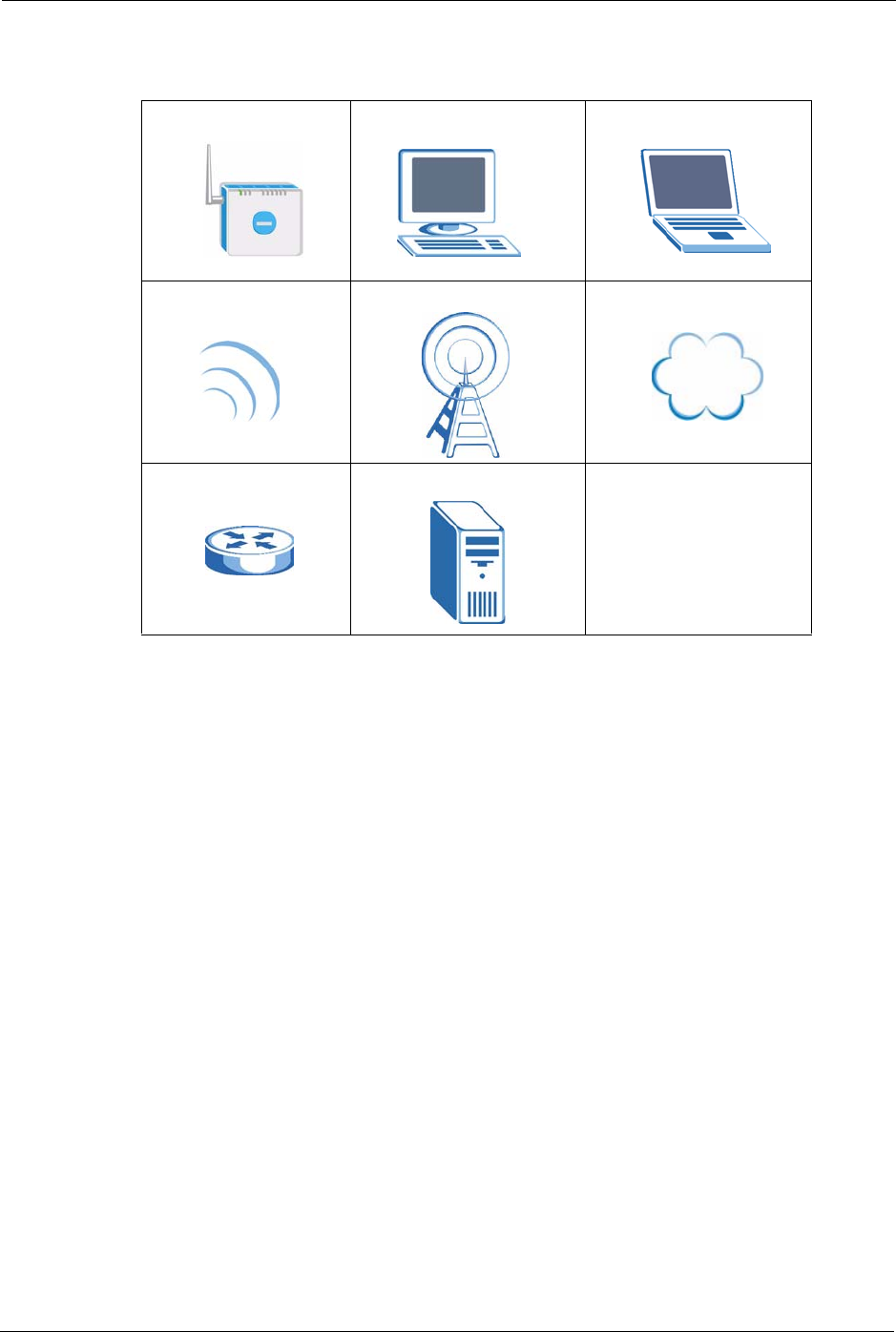
ZyXEL MAX-200M1 Series User’s Guide
28 Preface
Graphics Icons Key
ZyXEL Device Computer Notebook Computer
Wireless Signal Wireless Base Station Internet Cloud
Router Server

ZyXEL MAX-200M1 Series User’s Guide
Chapter 1 Getting Started 29
CHAPTER 1
Getting Started
This chapter introduces the main features and applications of the ZyXEL Device.
1.1 About Your ZyXEL Device
The ZyXEL Device is a WiMAX wireless network adapter. It allows you to access the Internet
by connecting to a WiMAX wireless network.
You can use a traditional analog telephone to make Internet calls using the ZyXEL Device’s
Voice over IP (VoIP) communication capabilities.
You can configure firewall and content filtering for secure Internet access, as well as a host of
other features.
The web browser-based Graphical User Interface (GUI), also known as the web configurator,
provides easy management.
See Appendix A on page 215 for a complete list of features for your model.
At the time of writing, this User’s Guide covers the following models:
This User’s Guide uses screens and example settings from the MAX-200M1 model.
1.1.1 Wireless Internet Access
Connect your computer or network to the ZyXEL Device for wireless Internet access. See the
Quick Start Guide for instructions on hardware connection.
In a wireless metropolitan area network (MAN), the ZyXEL Device connects to a base station
(BS) for Internet access.
The following diagram shows a notebook computer equipped with the ZyXEL Device
connecting to the Internet through a base station (marked BS).
Table 1 Models Covered
MAX-200M1
MAX-210M1
MAX-230M1
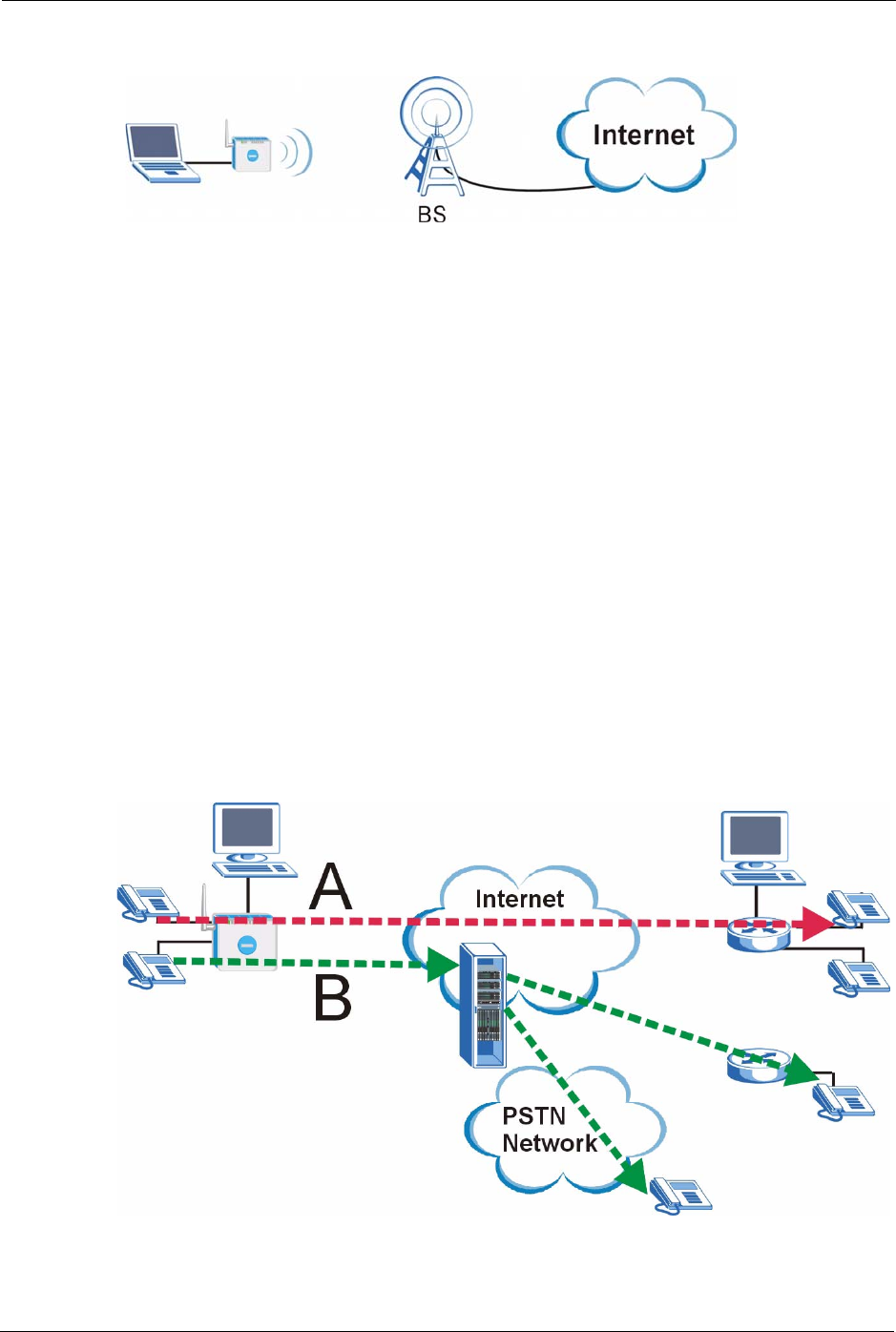
ZyXEL MAX-200M1 Series User’s Guide
30 Chapter 1 Getting Started
Figure 1 Mobile Station and Base Station
You can also configure firewall and content filtering on the ZyXEL Device for secure Internet
access. When the firewall is on, all incoming traffic from the Internet to your network is
blocked unless it is initiated from your network. This means that probes from the outside to
your network are not allowed, but you can safely browse the Internet and download files.
Use content filtering to block access to web sites with URLs containing keywords that you
specify. You can define time periods and days during which content filtering is enabled and
include or exclude particular computers on your network from content filtering. For example,
you could block access to certain web sites for the kids.
1.1.2 Make Calls via Internet Telephony Service Provider
In a home or small office environment, you can use the ZyXEL Device to make and receive
the following types of VoIP telephone calls:
• Peer-to-Peer calls (A) - Use the ZyXEL Device to make a call to the recipient’s IP address
without using a SIP proxy server.
• Calls via a VoIP service provider (B) - The ZyXEL Device sends your call to a VoIP
service provider’s SIP server which forwards your calls to either VoIP or PSTN phones.
Figure 2 ZyXEL Device’s VoIP Features

ZyXEL MAX-200M1 Series User’s Guide
Chapter 1 Getting Started 31
1.2 ZyXEL Device Hardware
Follow the instructions in the Quick Start Guide to make hardware connections.
1.2.1 LEDs
The following figure shows the LEDs (lights) on the ZyXEL Device.
Figure 3 The ZyXEL Device
The following table describes your ZyXEL Device’s LEDs.
Table 2 The ZyXEL Device
LED STATE DESCRIPTION
PWR OFF The ZyXEL Device is not receiving power.
RED The ZyXEL Device is receiving power but has been unable to start
up correctly. See the Troubleshooting section for more information.
RED / ORANGE
(BLINKING)
The ZyXEL Device is starting up.
GREEN The ZyXEL Device is receiving power and functioning correctly.
GREEN (BLINKING) The ZyXEL Device is performing a self-test.

ZyXEL MAX-200M1 Series User’s Guide
32 Chapter 1 Getting Started
1.2.2 Antenna
Connect the supplied 2dBi omni antenna to the SMA connector on the side of the ZyXEL
Device. Alternatively, use a higher-powered antenna with a female SMA connector (not
supplied) for improved signal reception.
The ZyXEL Device is equipped with an internal 6dBi directional patch antenna. If your signal
strength is poor (use the SIGNAL LEDs to gauge received signal strength) orient the front of
the ZyXEL Device (the side with the LEDs) towards the base station. If you do not know the
location of the base station, experiment with moving the ZyXEL Device while observing the
SIGNAL LEDs.
LAN OFF The LAN is not connected.
GREEN The ZyXEL Device has a successful Local Area Network (Ethernet)
connection.
GREEN
(BLINKING)
Your device is sending/receiving data through the wireless LAN.
VoIP OFF No SIP account is registered, or the ZyXEL Device is not receiving
power.
GREEN A SIP account is registered.
GREEN
(BLINKING)
A SIP account is registered, and the phone attached to the LINE
port is in use (off the hook).
ORANGE A SIP account is registered and has a voice message.
ORANGE
(BLINKING)
A SIP account is registered and has a voice message, and the
phone attached to the LINE port is in use (off the hook).
LINK OFF The ZyXEL Device is not connected to a wireless (WiMAX)
network.
GREEN The ZyXEL Device is successfully connected to a wireless
(WiMAX) network.
GREEN
(BLINKING SLOWLY)
The ZyXEL Device is searching for a wireless (WiMAX) network.
GREEN
(BLINKING QUICKLY)
The ZyXEL Device has found a wireless (WiMAX) network and is
connecting.
SIGNAL
1 ~ 5
The SIGNAL LEDs display the Received Signal Strength Indication (RSSI) of the wireless
(WiMAX) connection.
NO SIGNAL LEDS ON There is no wireless connection.
SIGNAL 1 ON The signal strength is less than -80 dBm
SIGNAL 2 ON The signal strength is between -79 and -70 dBm
SIGNAL 3 ON The signal strength is between -69 and -60 dBm
SIGNAL 4 ON The signal strength is between -59 and -50 dBm
SIGNAL 5 ON The signal strength is between -49 and -30 dBm
Table 2 The ZyXEL Device
LED STATE DESCRIPTION

ZyXEL MAX-200M1 Series User’s Guide
Chapter 2 Introducing the Web Configurator 33
CHAPTER 2
Introducing the Web
Configurator
This chapter describes how to access and navigate the web configurator.
2.1 Web Configurator Overview
The web configurator is an HTML-based management interface that allows easy device setup
and management via Internet browser. Use Internet Explorer 6.0 and later or Netscape
Navigator 7.0 and later versions. The recommended screen resolution is 1024 by 768 pixels.
In order to use the web configurator you need to allow:
• Web browser pop-up windows from your device. Web pop-up blocking is enabled by
default in Windows XP SP (Service Pack) 2.
• JavaScripts (enabled by default).
• Java permissions (enabled by default).
See the Troubleshooting chapter if you need to make sure these functions are allowed in
Internet Explorer.
2.1.1 Accessing the Web Configurator
1Make sure your ZyXEL Device hardware is properly connected (refer to the Quick Start
Guide).
2Launch your web browser.
3Type "192.168.1.1" as the URL.
4A password screen displays. The default password (“1234”) displays in non-readable
characters. If you haven’t changed the password yet, you can just click Login. Click
Cancel to revert to the default password in the password field. If you have changed the
password, enter your password and click Login.
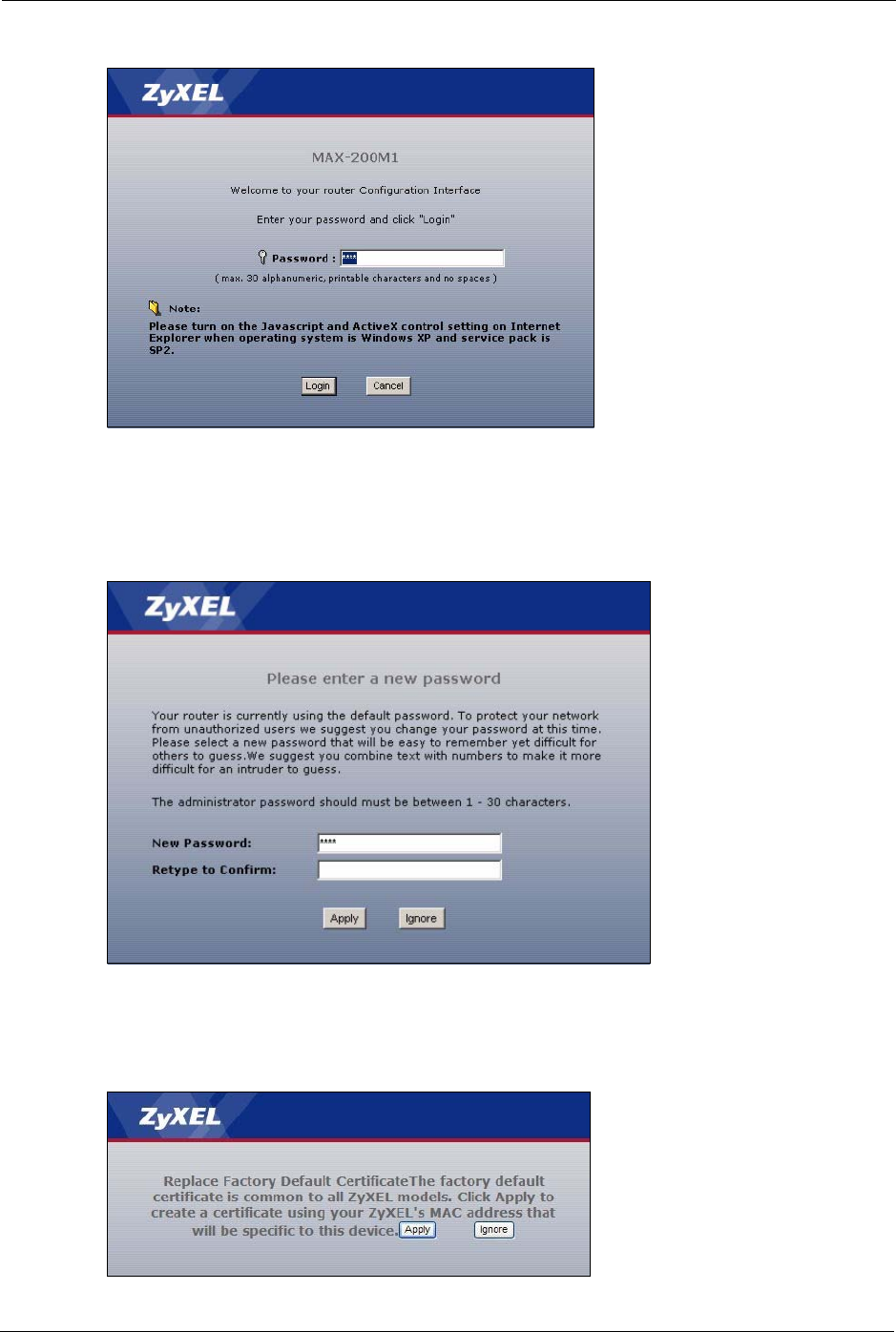
ZyXEL MAX-200M1 Series User’s Guide
34 Chapter 2 Introducing the Web Configurator
Figure 4 Password Screen
5The following screen displays if you have not yet changed your password. It is highly
recommended you change the default password. Enter a new password, retype it to
confirm and click Apply; alternatively click Ignore to proceed to the main menu if you
do not want to change the password now.
Figure 5 Change Password Screen
6Click Apply in the next screen to create a certificate using your ZyXEL Device’s MAC
address that will be specific to this device. This certificate is used for authentication when
using a secure HTTPS connection over the Internet.
Figure 6 Replace Certificate Screen
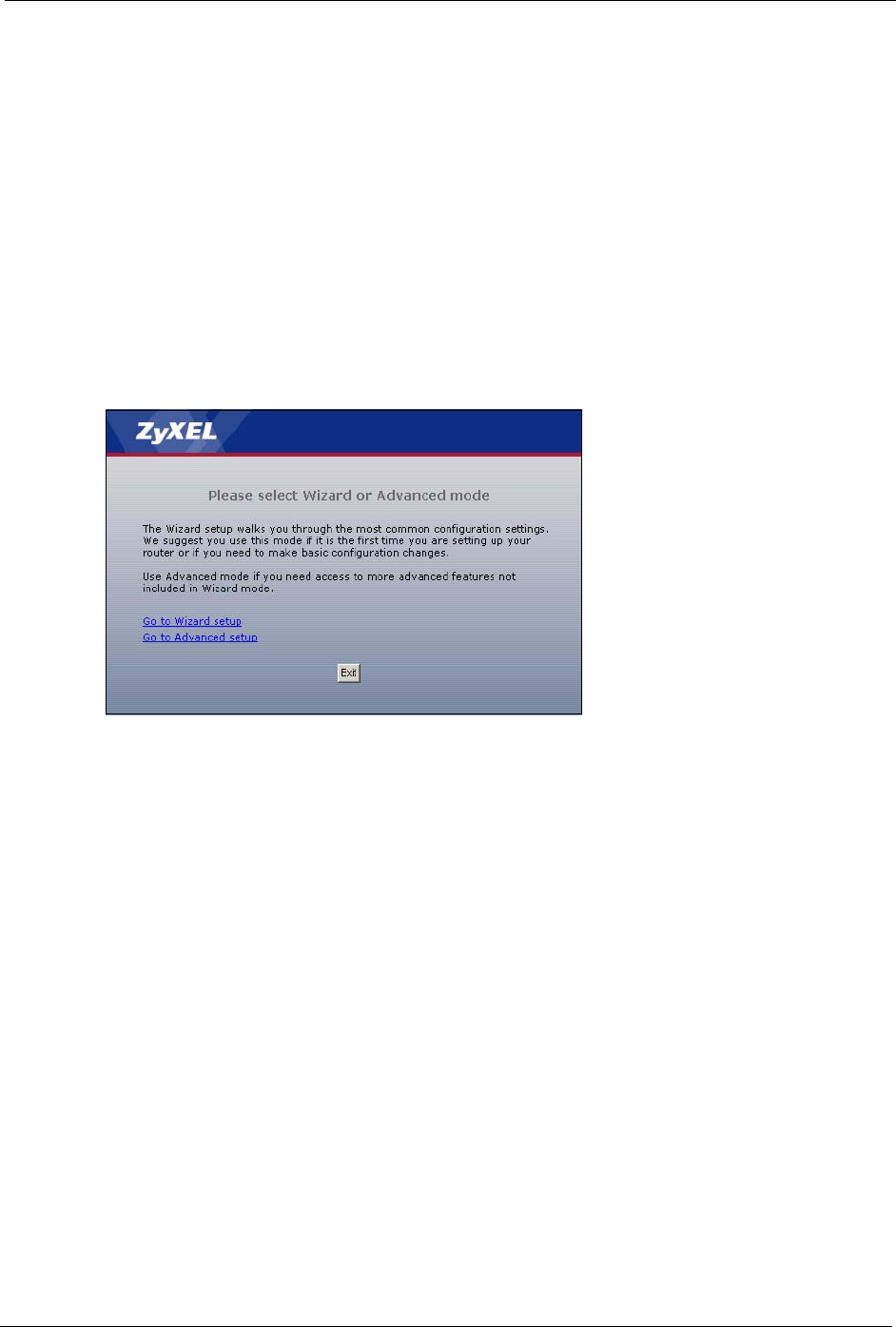
ZyXEL MAX-200M1 Series User’s Guide
Chapter 2 Introducing the Web Configurator 35
7 A screen displays to let you choose whether to go to the wizard or the advanced screens.
• Click Go to Wizard setup if you are logging in for the first time or if you want to make
basic changes. The wizard selection screen appears after you click Apply. See Chapter 4
on page 49 for more information.
• Click Go to Advanced setup if you want to configure features that are not available in
the wizards. The main screen appears after you click Apply. See Section 2.2 on page 36
for more information.
• Click Exit if you want to log out.
Note: For security reasons, by default the ZyXEL Device automatically logs you out if
you do not use the web configurator for five minutes. If this happens, log in
again.
Figure 7 Wizard or Advanced Screen
2.1.2 The RESET Button
If you forget your password or cannot access the web configurator, you will need to use the
RESET button to reload the factory-default configuration file. This means that you will lose
all configurations that you had previously and the password will be reset to “1234”.
2.1.2.1 Using The Reset Button
1Make sure the POWER light is on (not blinking).
2To set the device back to the factory default settings, press the RESET button for ten
seconds or until the POWER light begins to blink and then release it. When the POWER
light begins to blink, the defaults have been restored and the device restarts.
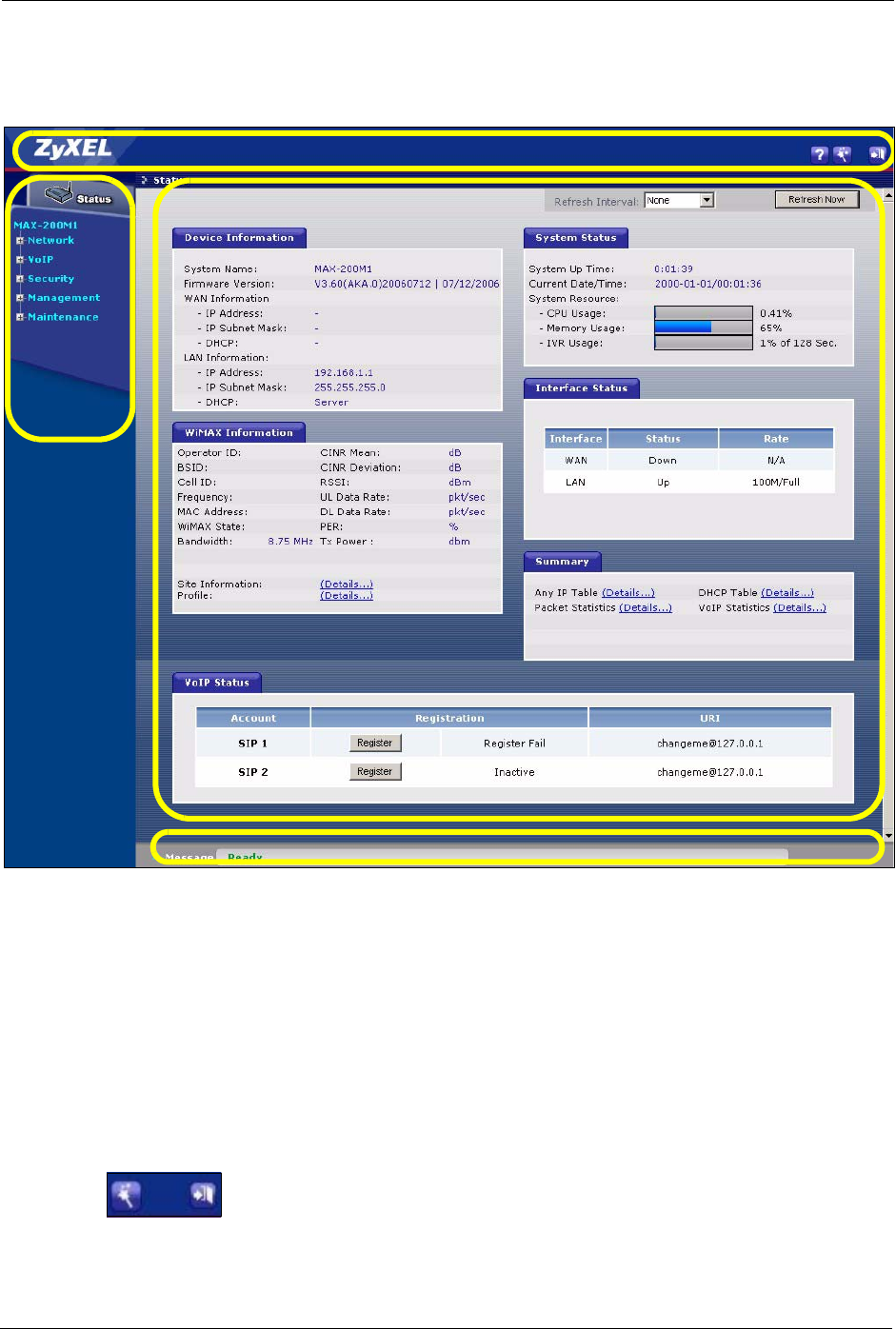
ZyXEL MAX-200M1 Series User’s Guide
36 Chapter 2 Introducing the Web Configurator
2.2 Web Configurator Main Screen
Figure 8 Main Screen
As illustrated above, the main screen is divided into these parts:
•A - title bar
•B - navigation panel
•C - main window
•D - status bar
2.2.1 Title Bar
The title bar provides some icons in the upper right corner.
C
B
A
D
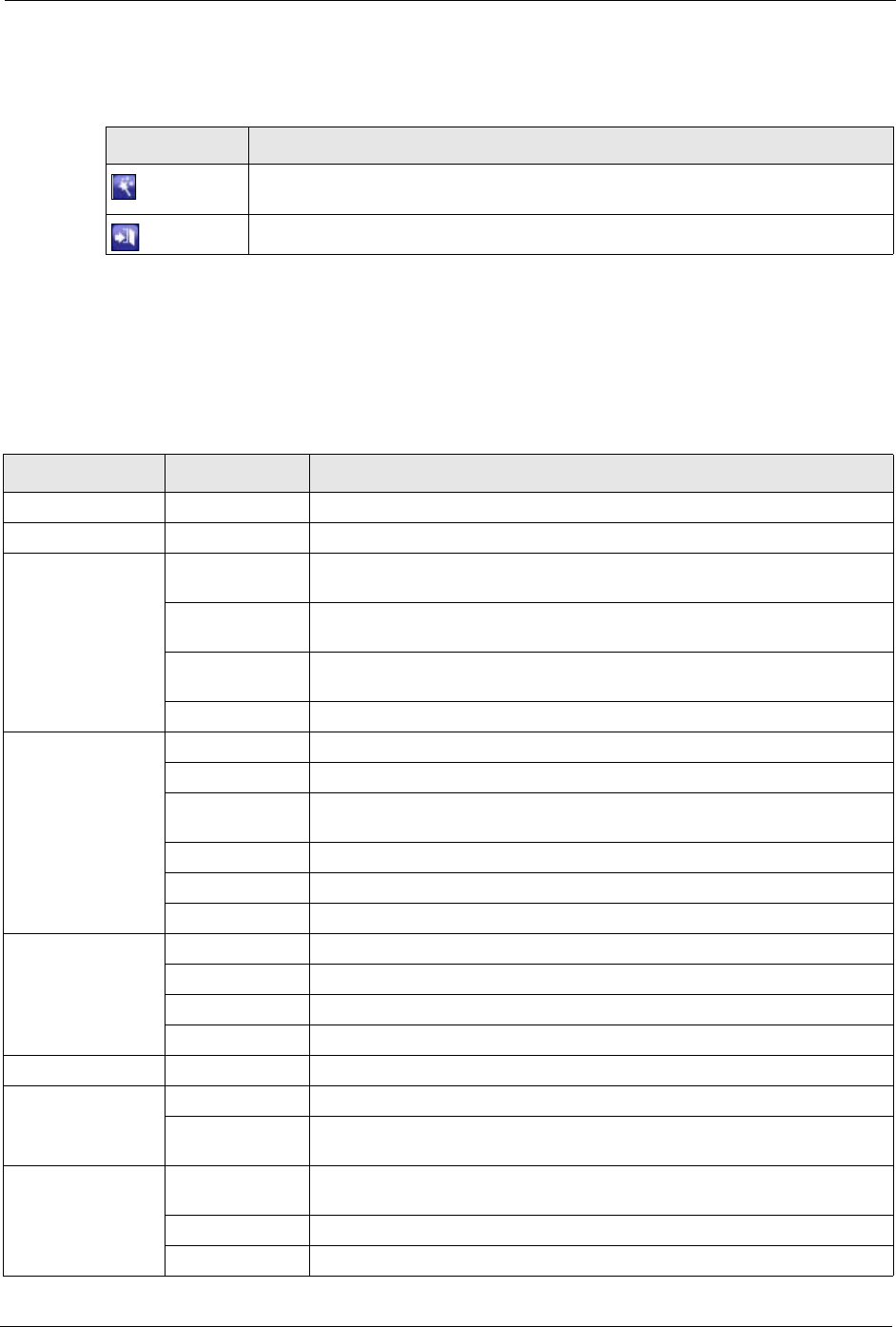
ZyXEL MAX-200M1 Series User’s Guide
Chapter 2 Introducing the Web Configurator 37
The icons have the following functions.
2.2.2 Navigation Panel
Use the menu items on the navigation panel to open screens to configure ZyXEL Device
features. The following table describes the menu items.
Table 3 Web Configurator Icons in the Title Bar
ICON DESCRIPTION
Wizards: Click this icon to go to the configuration wizards. See Chapter 4 on page
49 for more information.
Logout: Click this icon to log out of the web configurator.
Table 4 Navigation Panel Summary
LINK TAB FUNCTION
Status This screen contains administrative and system-related information.
Network
WAN Internet
Connection
Use this screen to configure ISP parameters, WAN IP address assignment
and other advanced properties.
WiMAX
Frequency
Use this screen to set the radio frequencies the ZyXEL Device searches for
a WiMAX connection.
Advanced Use this screen to configure DNS servers, RIP & Multicast, and Windows
networking settings.
Traffic Redirect Use this screen to configure your traffic redirect properties
LAN IP Use this screen to configure LAN TCP/IP settings.
DHCP Setup Use this screen to configure LAN DHCP and DNS settings.
Static DHCP Use this screen to always assign specific IP addresses to individual MAC
addresses.
Client List Use this screen to view current DHCP client information.
IP Alias Use this screen to partition your LAN interface into subnets.
Advanced Use this screen to enable Any IP
NAT General Use this screen to enable NAT.
Port Forwarding Use this screen to make your local servers visible to the outside world.
Trigger Port Use this screen to set port triggering rules.
ALG Use this screen to configure Application Level Gateway settings.
VoIP
SIP SIP Settings Use this screen to configure your ZyXEL Device’s Voice over IP settings.
QoS Use this screen to configure your ZyXEL Device’s Quality of Service
settings for VoIP.
Phone Analog Phone Use this screen to set which SIP account to use for outgoing or incoming
calls.
Common Use this screen to configure general phone settings.
Region Use this screen to select your location and call service mode.
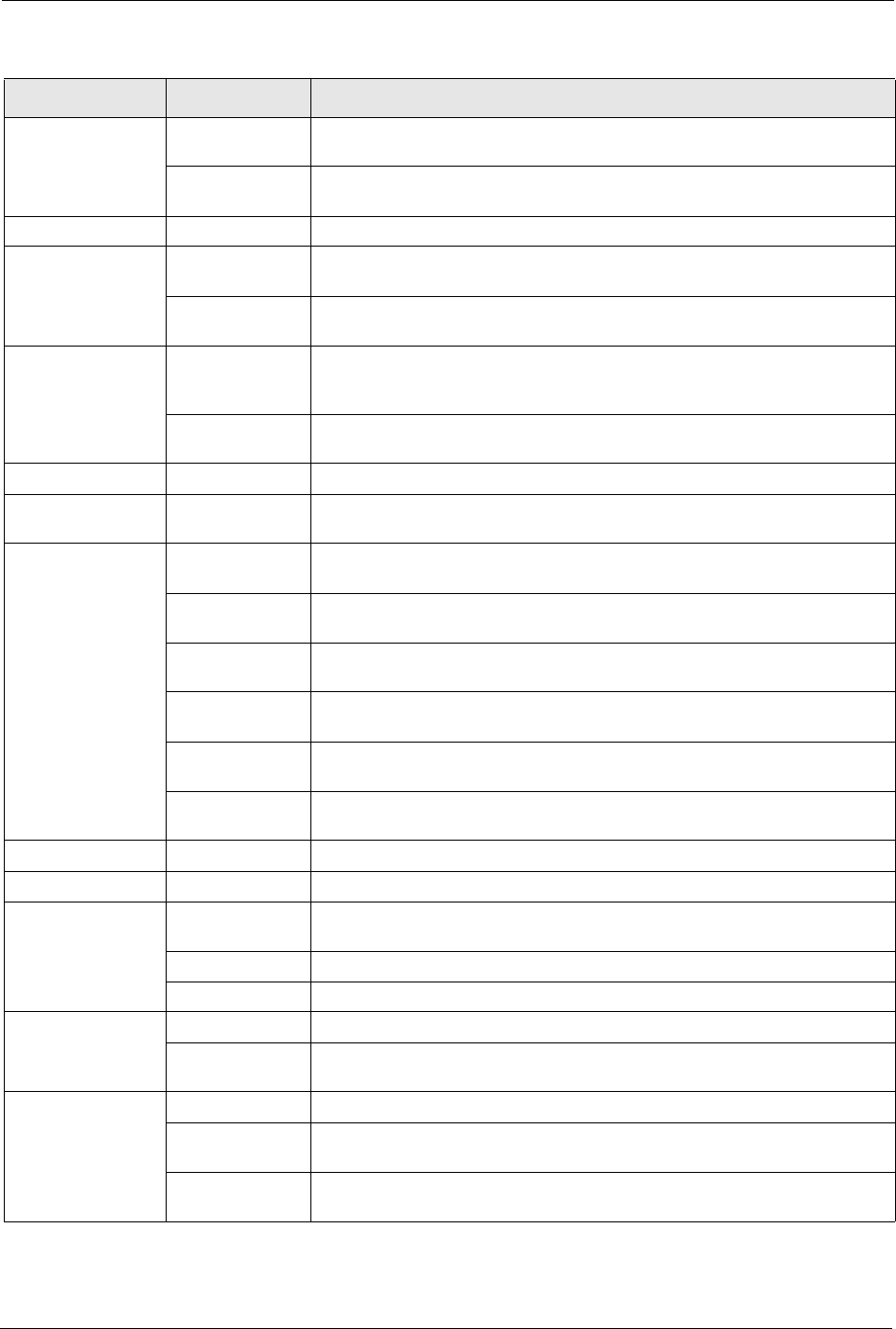
ZyXEL MAX-200M1 Series User’s Guide
38 Chapter 2 Introducing the Web Configurator
Phone Book Incoming Call
Policy
Use this screen to configure call-forwarding.
Speed Dial Use this screen to configure speed dial for SIP phone numbers that you call
often.
Security
Firewall General Use this screen to activate/deactivate the firewall and the default action to
take on network traffic going in specific directions.
Services Use this screen to set the days and times for your device to perform service
blocking.
Content Filter Filter Use this screen to block sites containing certain keywords in the URL,
exclude a range of users on the LAN from content filtering on your ZyXEL
Device and restrict certain web features.
Schedule Use this screen to set the days and times for your ZyXEL Device to perform
content filtering.
Management
Static Route IP Static Route Use this screen to configure IP static routes to tell your device about
networks beyond the directly connected remote nodes.
Remote MGMT WWW Use this screen to configure through which interface(s) and from which IP
address(es) users can use HTTP to manage the ZyXEL Device.
Telne t Use this screen to configure through which interface(s) and from which IP
address(es) users can use Telnet to manage the ZyXEL Device.
FTP Use this screen to configure through which interface(s) and from which IP
address(es) users can use FTP to access the ZyXEL Device.
SNMP Use this screen to configure your ZyXEL Device’s settings for Simple
Network Management Protocol management.
DNS Use this screen to configure through which interface(s) and from which IP
address(es) users can send DNS queries to the ZyXEL Device.
Security Use this screen to set whether or not your device will respond to pings and
probes for services that you have not made available.
UPnP General Use this screen to turn UPnP on or off.
Maintenance
System General This screen contains administrative and system-related information and
also allows you to change your password.
Dynamic DNS Use this screen to set up Dynamic DNS.
Time Setting Use this screen to change your ZyXEL Device’s time and date.
Logs View Log Use this screen to display your device’s logs.
Log Settings Use this screen to select which logs and/or immediate alerts your device is
to record. You can also set it to e-mail the logs to you.
Tools Firmware Use this screen to upload firmware to your device.
Configuration Use this screen to backup and restore your device’s configuration (settings)
or reset the factory default settings.
Restart This screen allows you to reboot the ZyXEL Device without turning the
power off.
Table 4 Navigation Panel Summary
LINK TAB FUNCTION

ZyXEL MAX-200M1 Series User’s Guide
Chapter 2 Introducing the Web Configurator 39
2.2.3 Main Window
The main window displays information and configuration fields. It is discussed in the rest of
this document.
Right after you log in, the Status screen is displayed. See Chapter 6 on page 59 for more
information about the Status screen.
2.2.4 Status Bar
Check the status bar when you click Apply or OK to verify that the configuration has been
updated.

ZyXEL MAX-200M1 Series User’s Guide
40 Chapter 2 Introducing the Web Configurator
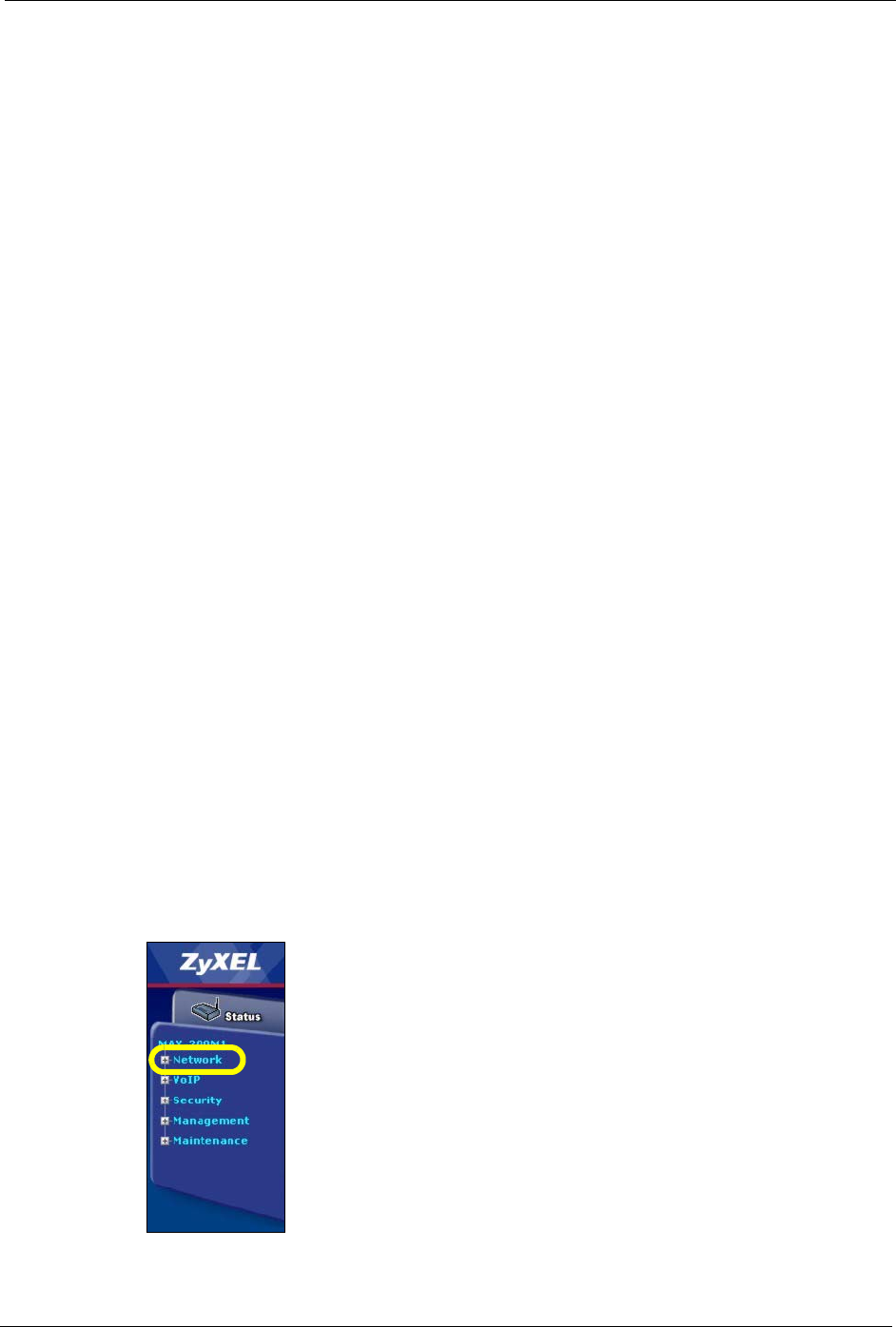
ZyXEL MAX-200M1 Series User’s Guide
Chapter 3 Tutorial 41
CHAPTER 3
Tutorial
This chapter provides examples showing how to use the ZyXEL Device to access the Internet,
set up VoIP and make a telephone call over the Internet using the ZyXEL Device’s speed dial
feature.
3.1 Connect to the Internet
This section shows how to set up your Internet access details on the ZyXEL Device and
configure your WiMAX frequency settings. See Section 7.2 on page 71 for more information
on how WiMAX works.
3.1.1 Configure Internet Access Settings
To access the Internet, you need information from your Internet Service Provider (ISP) about
your account and the network. In this example, your user name is ‘User1234’ and your
password is ‘4321’.
Your ISP has also told you that you will be assigned a dynamic IP address each time you
connect to the Internet. See Section 7.3 on page 72 for more details about dynamic and static
IP addresses.
Once you have connected the ZyXEL Device to your computer and accessed the Web
Configurator (see the Quick Start Guide for details) follow the steps below to connect to a
network.
1In the Web Configurator, click Network > WAN in the navigation panel.
Figure 9 Tutorial: Navigation Panel
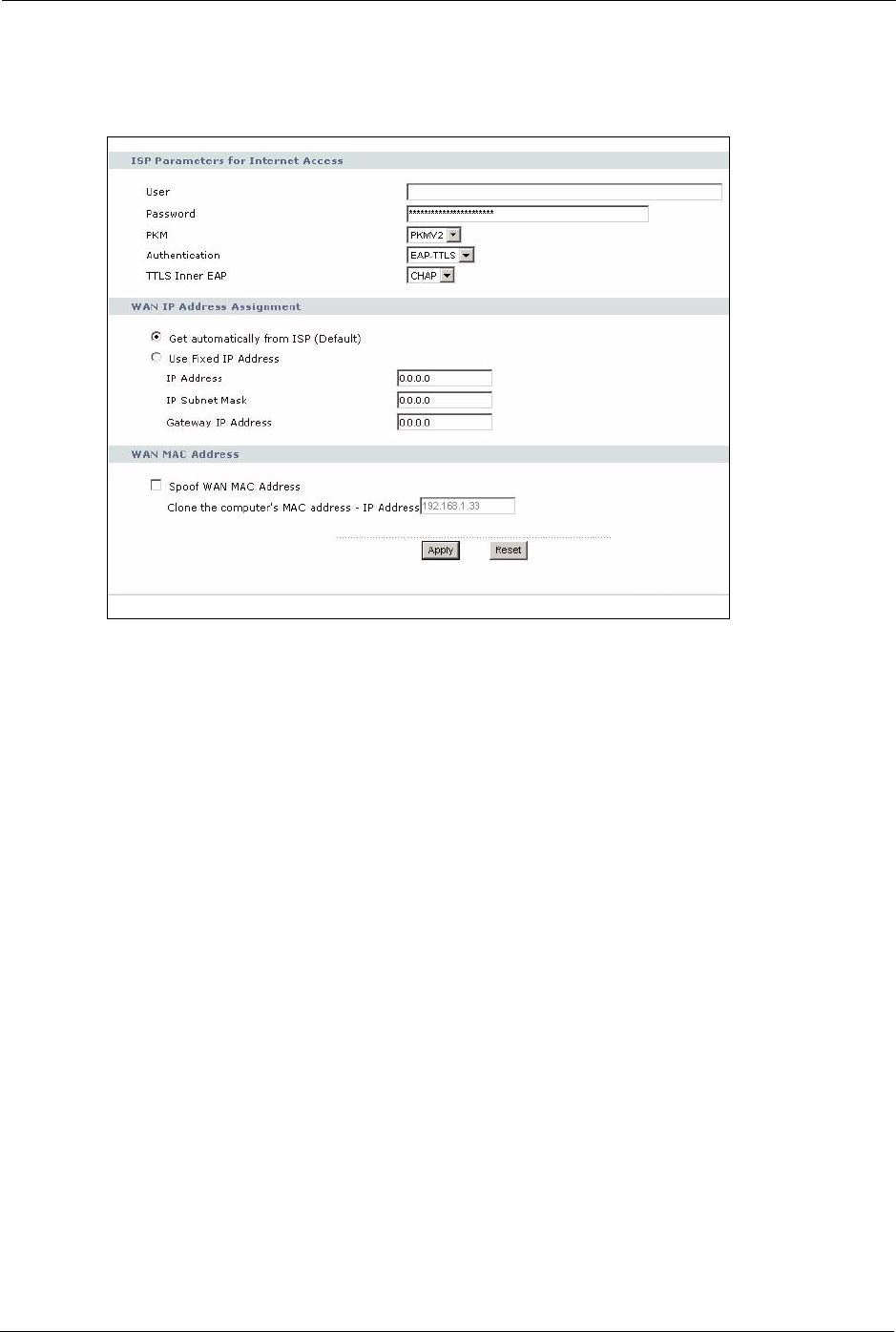
ZyXEL MAX-200M1 Series User’s Guide
42 Chapter 3 Tutorial
2The following screen displays. This screen is where you enter your Internet access
details.
Figure 10 Tutorial: Internet Access Settings
In the ISP Parameters for Internet Access area, enter your username (‘User1234’) in
the User field, and enter your password (‘4321’) in the Password field. Your ISP gave no
information about the other fields in this section, so leave them at their defaults.
In the WAN IP Address Assignment area, make sure that Get Automatically from ISP
(Default) is selected. Leave all other fields at their default values.
3Click Apply. Your Internet access settings are saved to the ZyXEL Device, and are used
automatically each time you connect to the Internet.
3.1.2 Configure WiMAX Settings
The WiMAX Frequency screen allows you to specify a set of frequencies to search for a
connection to a base station. Before you start, you need information from your ISP about the
supported frequencies.
In this example, your ISP has told you that the supported WiMAX frequencies are at 2.55 and
2.56 Gigahertz (GHz). See Section 7.4 on page 74 for more information on radio frequencies.
Follow the steps below to configure your frequency settings.
1Click Network > WAN > WiMAX Frequency to open the screen shown next.
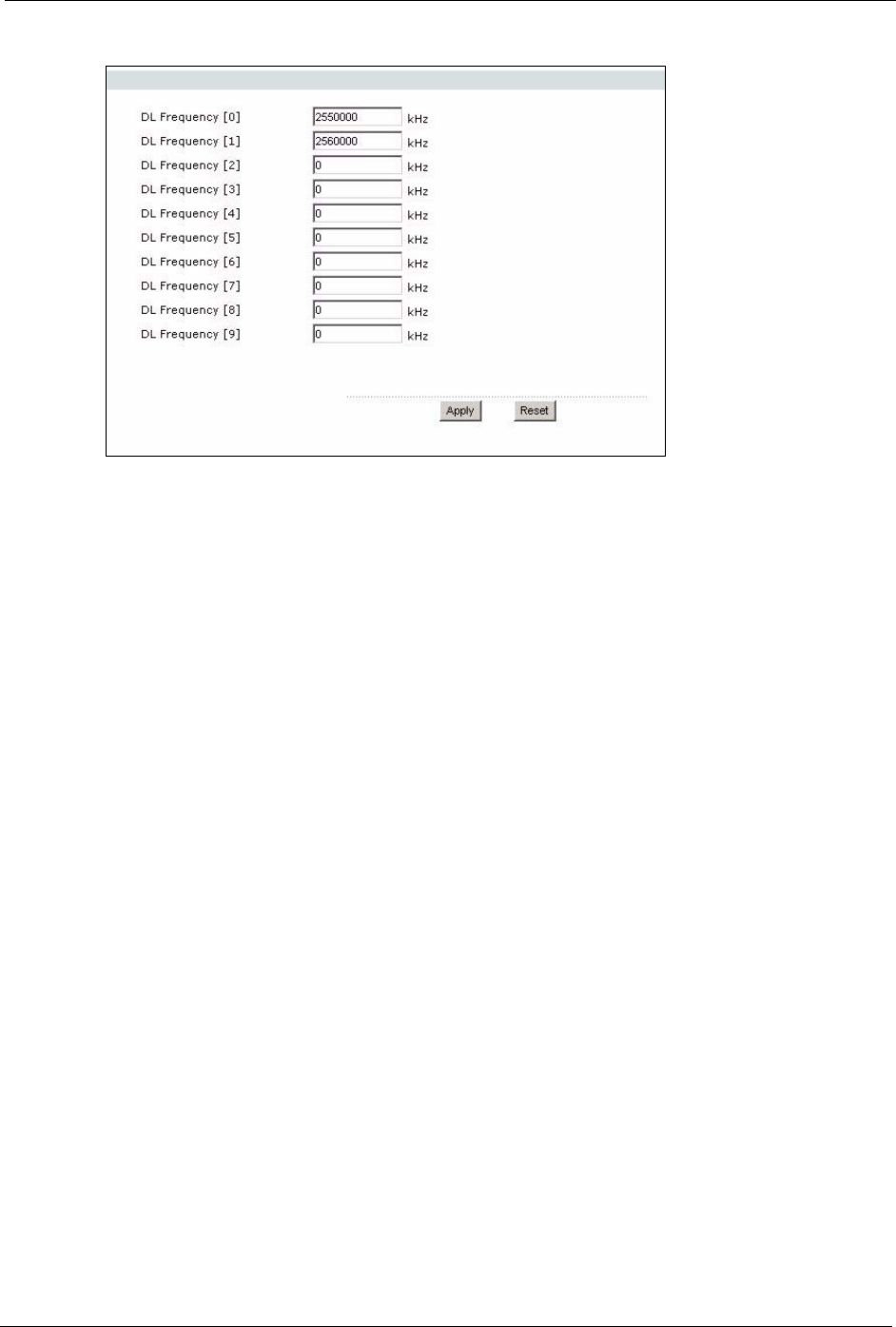
ZyXEL MAX-200M1 Series User’s Guide
Chapter 3 Tutorial 43
Figure 11 Tutorial: WiMAX Frequency Setup
2Enter the frequency settings your ISP gave you in the DL Frequency fields. Note that
these fields are in kilohertz (kHz).
2.55 GHz is equal to 2550000 kHz, so enter 2550000 in the DL Frequency [0] field.
2.56 GHz is equal to 2560000 kHZ, so enter 2560000 in the DL Frequency [1] field.
3Click Apply to save your settings. The ZyXEL Device scans for an available wireless
connection at the DL Frequency [0] setting (2.55 GHz) and, if it does not find an
available connection, searches at the DL Frequency [1] setting (2.56 GHz). When it
finds an available connection, the fields in this screen will be automatically set to use that
frequency.
For an example of using the WiMAX Frequency screen to configure more frequencies,
see Section 7.4.2.1 on page 77.
4Look at the LEDs on your ZyXEL Device. When the ZyXEL Device successfully
connects to a base station, the LINK LED shines green steadily. The SIGNAL 1 ~ 5
LEDs indicate the signal strength, with SIGNAL 5 showing a very strong signal and
SIGNAL 1 showing a very weak signal.
5Open your Internet browser and enter http://www.zyxel.com or the URL of any other web
site in the address bar. If you are able to access the web site, your wireless connection is
successfully configured. If you cannot access the web site, check the Troubleshooting
section of this User's Guide.
3.2 Make a Telephone Call Over the Internet
To make a call over the Internet using the ZyXEL Device, first do the following things:
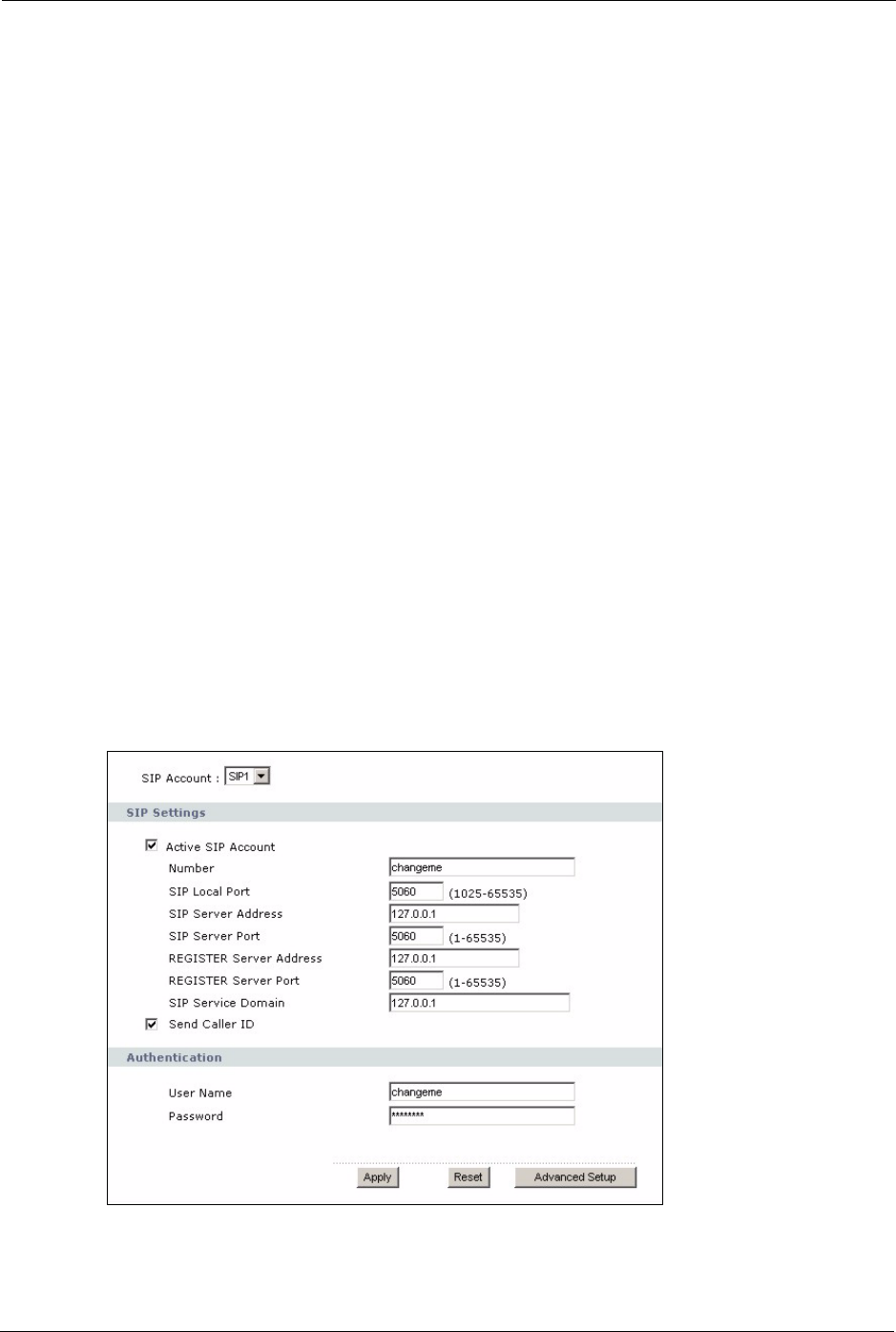
ZyXEL MAX-200M1 Series User’s Guide
44 Chapter 3 Tutorial
• Set up hardware connections from the ZyXEL Device to your computer, your telephone
and the power supply (see the Quick Start Guide for more details on hardware
connections).
• Set up your Internet access and WiMAX settings on the ZyXEL Device (see Section 3.1.1
on page 41 and Section 3.1.2 on page 42 for examples).
• Set up an account with a Voice over IP (VoIP) provider. This account (called a SIP
account) allows you to make calls over the Internet. See Chapter 10 on page 105 for more
information on SIP accounts.
Use the sections below to set up your SIP account and speed dialing, and place a VoIP call.
3.2.1 Configure Your SIP Account
Your ZyXEL Device needs to be configured with the details of your SIP account before you
can use it to make calls over the Internet. In this example, your SIP identity is
“id123@abcvoip.com”, your user name is “id123” and your password is “zyx987”. Your VoIP
provider has told you that the SIP server address is “sipserver-abcvoip.com”. See Section
10.1.3 on page 105 for more information on SIP identities.
Once you have connected the ZyXEL Device to your computer and accessed the Web
Configurator (see the Quick Start Guide for details) follow the steps below to configure your
SIP settings.
1In the Web Configurator, click VoIP > SIP in the navigation panel.
The following screen displays. This screen is where you enter your SIP account details.
Figure 12 Tutorial: SIP Account Setup
2Select SIP1 from the SIP Account list and make sure that the Active SIP Account box
is selected.
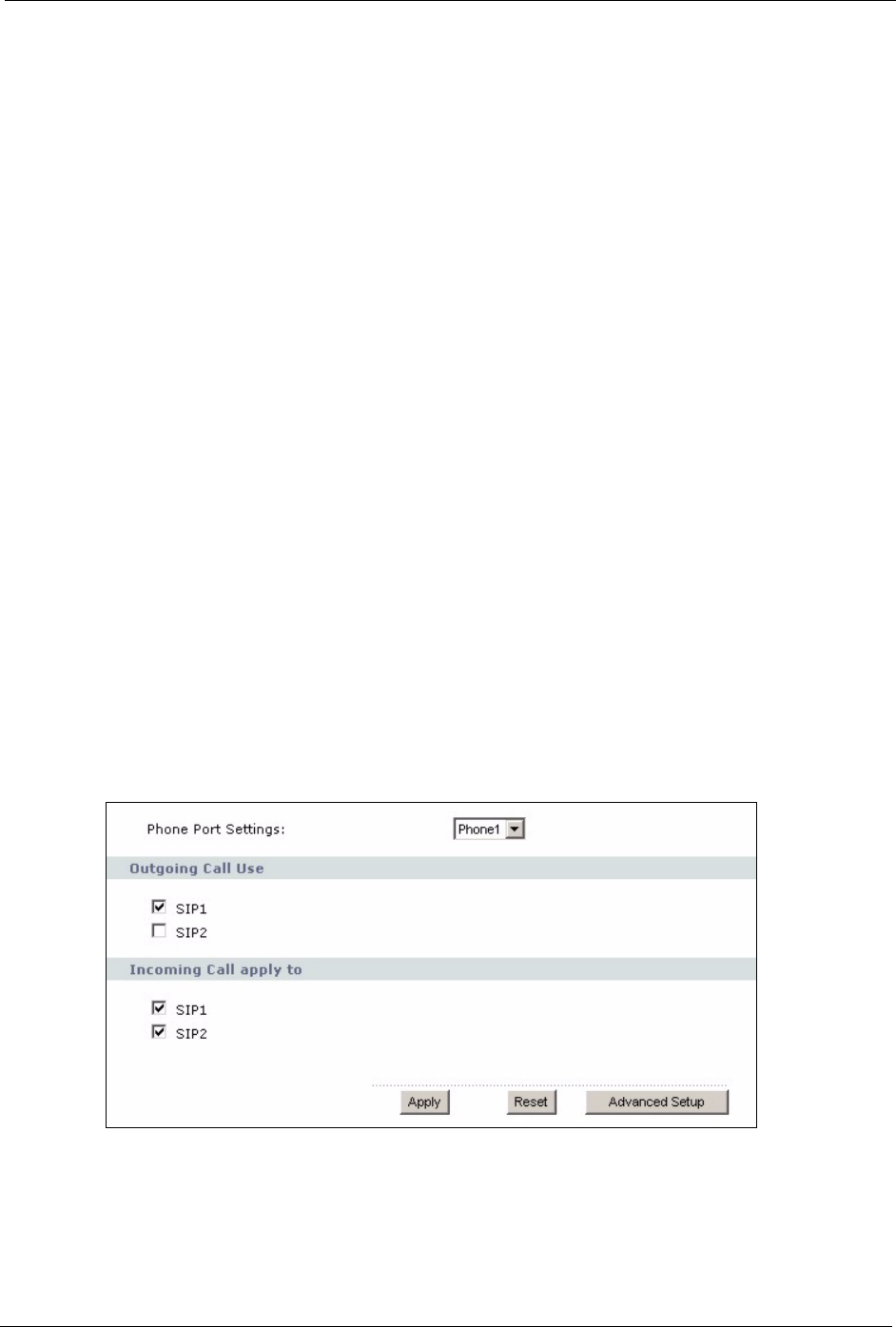
ZyXEL MAX-200M1 Series User’s Guide
Chapter 3 Tutorial 45
3Enter your SIP user name (‘id123’) in the Number field.
4Enter your VoIP provider’s SIP server name (‘sipserver-abcvoip.com’) in the SIP Server
Address field. As your VoIP provider did not give you a different REGISTER Server
Address, enter ‘sipserver-abcvoip.com’ again.
Enter your VoIP provider’s domain name (‘abcvoip.com’) in the SIP Service Domain
field.
5In the Authentication area, enter ‘id123’ in the User Name field, and ‘zyx987’ in the
Password field. Leave the SIP Local Port, SIP Server Port and REGISTER Server
Port fields at their default values, as your VoIP provider did not supply port details.
Click Apply.
6Click on the Status button in the navigation panel to check that your SIP account is
correctly registered.
Look in the VoIP St atus area towards the bottom of the Status screen. If the SIP 1
account displays Registered in the Registration field, it is ready to use.
If the Registration field for the SIP 1 account displays Register Fail or Inactive, click
the Register button, check your settings in the VoIP > SIP screen or contact your VoIP
provider to confirm that you have the correct settings and that your account is active.
3.2.2 Configure a Phone
Once you have set up your SIP account, click VoIP > Phone > Analog Phone in the
navigation panel. The following screen displays.
Figure 13 Tutorial: the Analog Phone Screen
Use this screen to make sure that the phone connected to your ZyXEL Device uses the correct
SIP account.
1Select Phone1 from the drop-down list box.
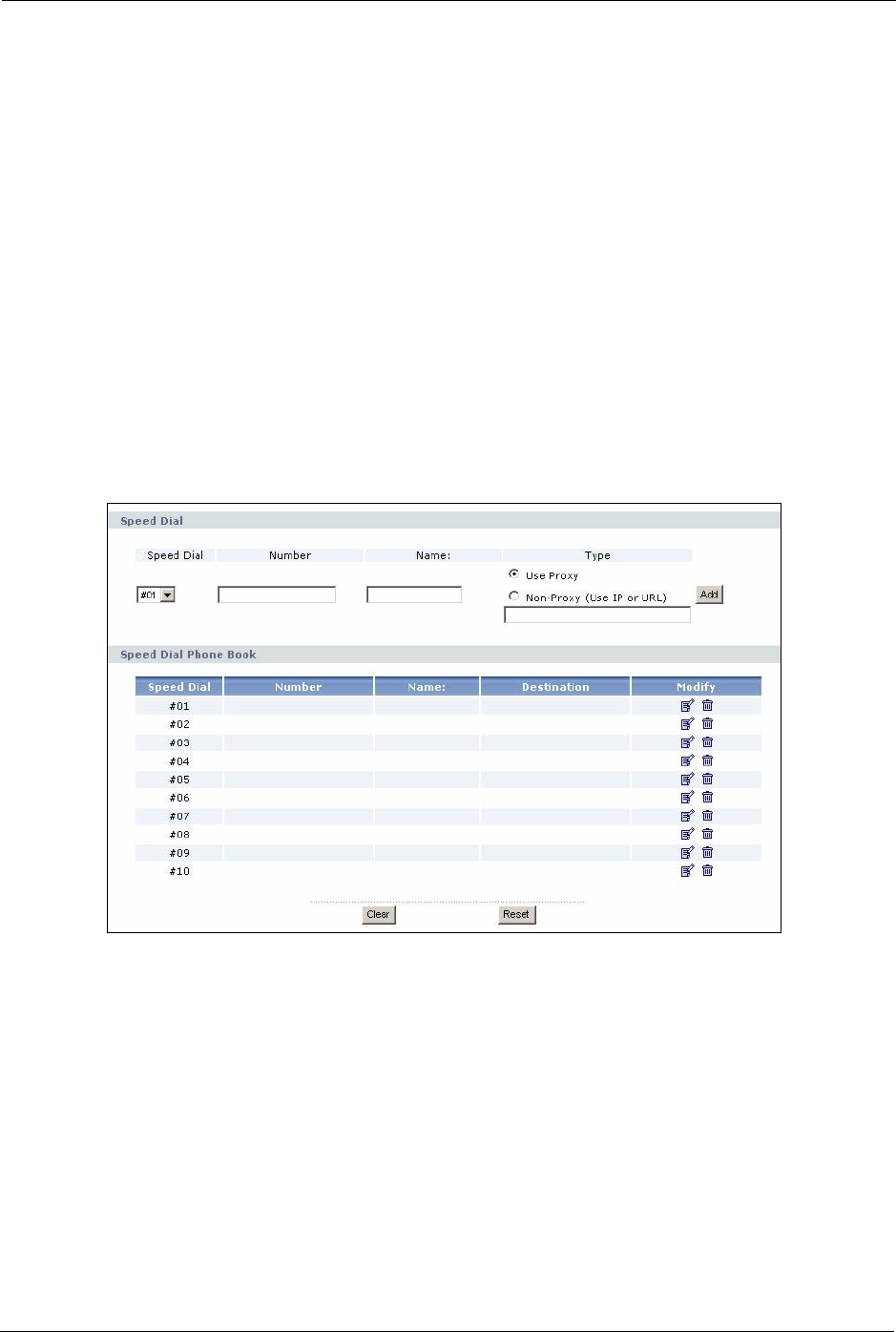
ZyXEL MAX-200M1 Series User’s Guide
46 Chapter 3 Tutorial
2In the Outgoing Call Use area, select SIP1.
3In the Incoming Call apply to area, select both SIP1 and SIP2.
4Click Apply. Your analog phone settings are saved.
3.2.3 Set Up Speed Dialing and Make a Call
In this example you want to set up speed dialling to make calls to a friend, Bob, whose SIP
account number is 2345@xyzvoip.com. Your voIP provider, abcvoip.com, has told you that to
call an xyzvoip.com number you must add ‘555’ at its start.
Note: Different VoIP providers implement calls to other networks in different ways.
Check with your provider for details.
To configure speed dialling on the ZyXEL Device, click VoIP > Phone Book > Speed Dial.
The following screen displays.
Figure 14 Tutorial: the Speed Dial Screen
Use the following steps to set up a speed dial entry.
1You can have up to ten speed dial rules. Select the rule number (1, in this example) from
the Speed Dial drop-down list box.
2In the Number field, enter “5552345” and in the Name field enter “Bob”. Under Type,
select Use Proxy and click Add.
The new speed dial rule is displayed in the Speed Dial Phone book List.
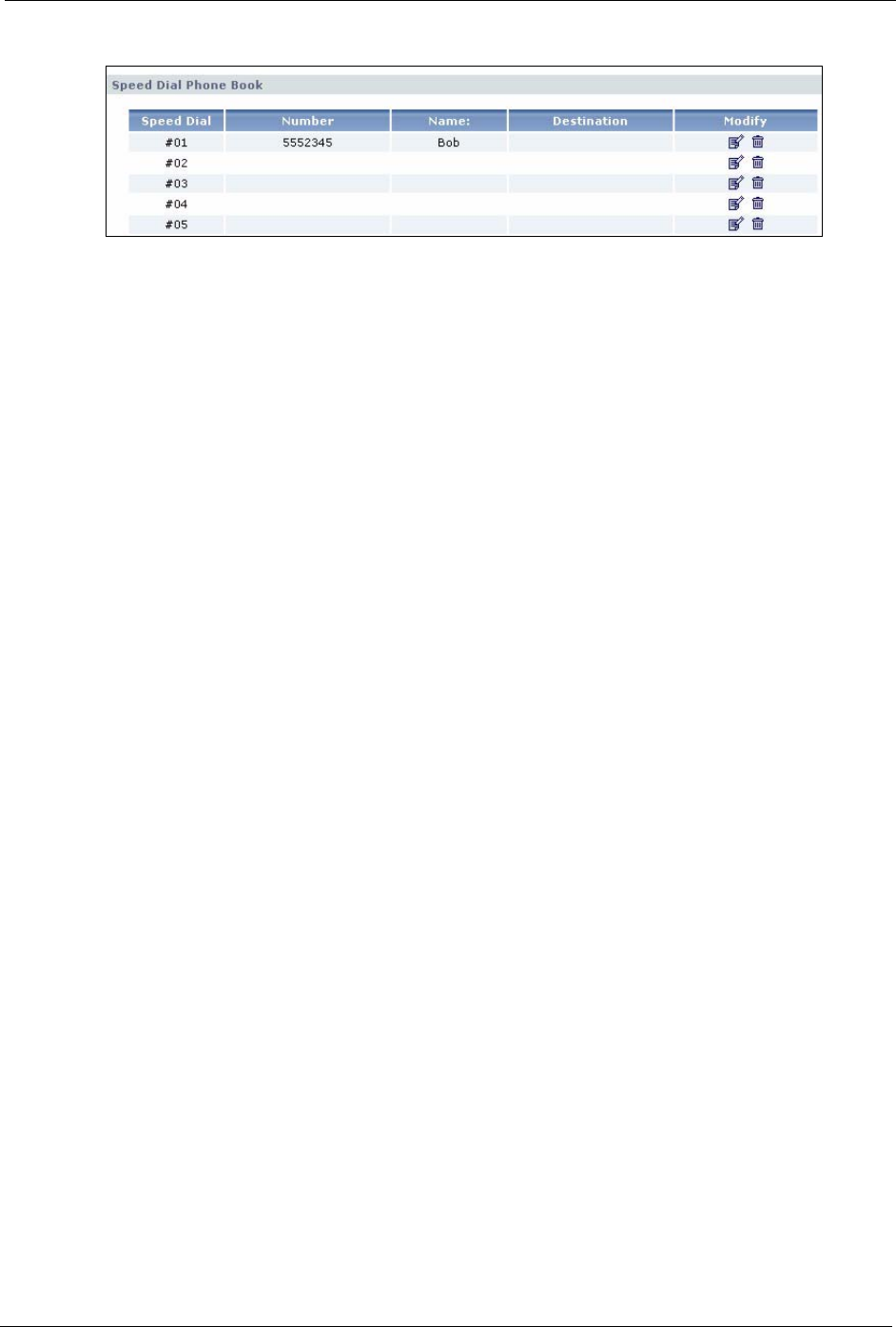
ZyXEL MAX-200M1 Series User’s Guide
Chapter 3 Tutorial 47
Figure 15 Tutorial: New Speed Dial Rule
Use the following steps to call a number from the speed dial list.
1Ensure that your phone is correctly connected to the ZyXEL Device. See the Quick Start
Guide for details of hardware connections.
2Lift the phone’s receiver and type the speed dial number exactly as it appears in the
Speed Dial Phone Book list. In this case, Bob’s phone number occupies rule #01, so dial
“#01” on the phone’s keypad to make the call.

ZyXEL MAX-200M1 Series User’s Guide
48 Chapter 3 Tutorial
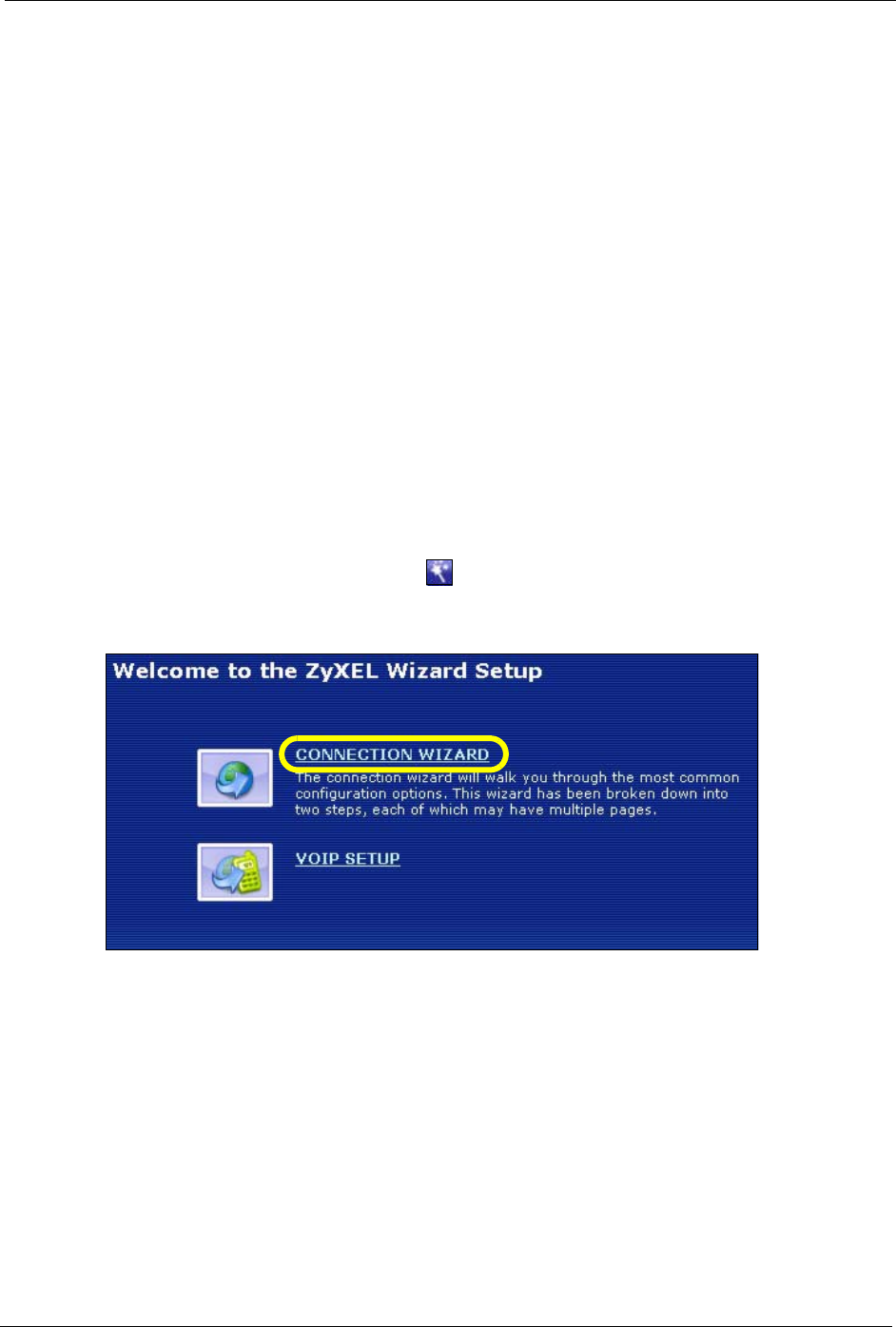
ZyXEL MAX-200M1 Series User’s Guide
Chapter 4 Internet Setup Wizard 49
CHAPTER 4
Internet Setup Wizard
This chapter provides information on the wizard setup screens for Internet access.
4.1 Wizard Setup Overview
The wizard will guide you through several steps. You will need to enter some information for
identification purposes, then the wizard will guide you through configuring your Internet
settings.
4.2 Internet Connection Wizard Setup
1After you enter the password to access the web configurator, select Go to Wizard setup.
Otherwise, click the wizard icon ( ) in the top right corner of the web configurator to go
to the wizards.
Figure 16 Select a Mode
2Click CONNECTION WIZARD to configure the system for Internet access.
3The following screen displays. Click Next to continue. Click Back at any time to return
to the previous screen, or Exit to leave the wizard setup.
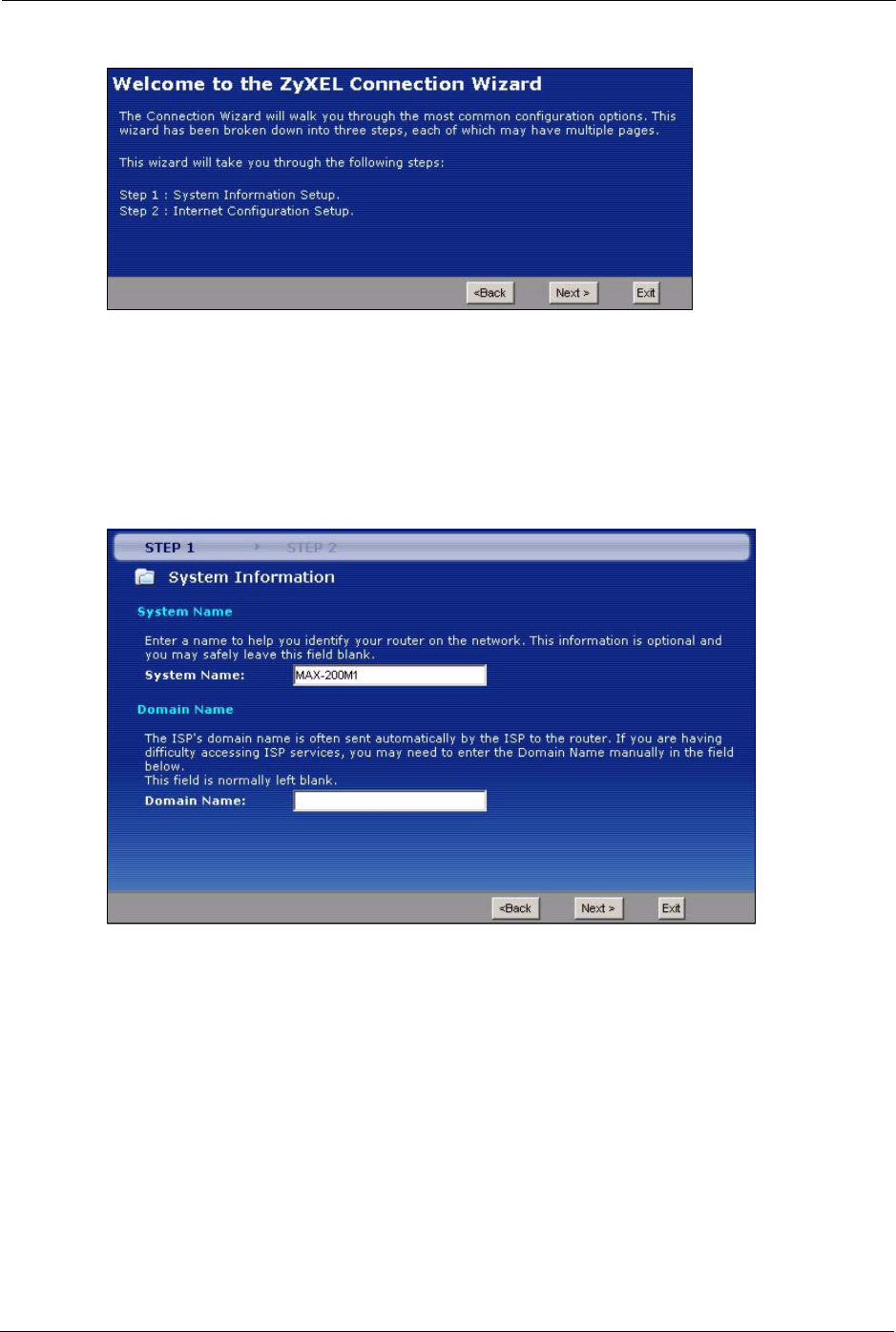
ZyXEL MAX-200M1 Series User’s Guide
50 Chapter 4 Internet Setup Wizard
Figure 17 Connection Wizard: Introduction
4In the next screen you can give your ZyXEL Device a name (optional) in the System
Name field. Enter up to thirty letters (this field is case-sensitive) or numbers. The ‘at’
symbol (@), dash (-), underscore (_) and period (.) are also permitted.
Enter your ISP’s IP address in the Domain Name field if your ISP has instructed you to
do so, or if you are having trouble accessing the Internet. Otherwise, leave this field
blank.
Figure 18 The Connection Wizard: System Information
5The following screen appears. Leave the Connection Type at the default setting and click
Next.
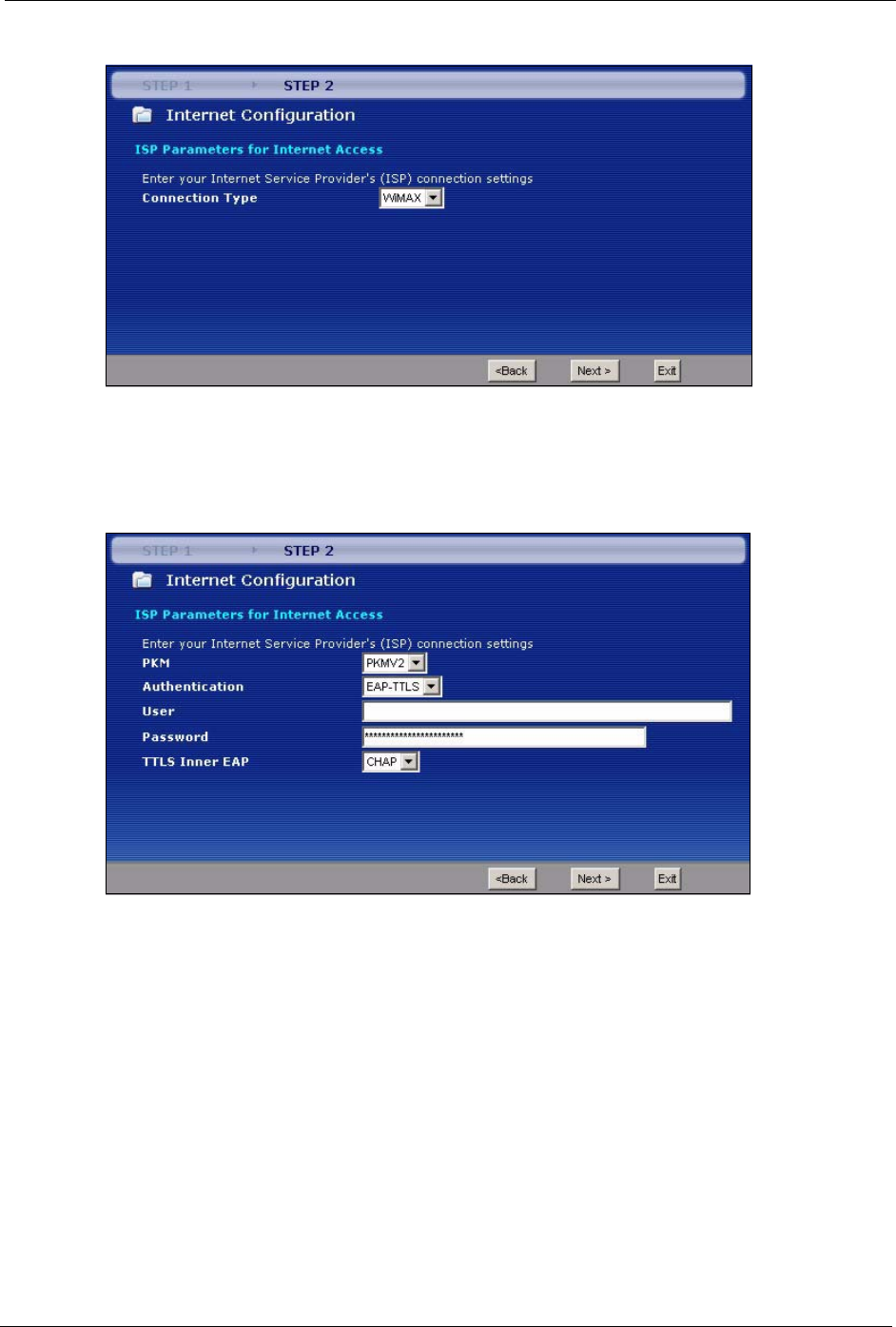
ZyXEL MAX-200M1 Series User’s Guide
Chapter 4 Internet Setup Wizard 51
Figure 19 The Connection Wizard: Internet Configuration 1
6 Enter your Internet account information (username and password) exactly as provided by
your ISP. Leave the PKM, Authentication and TTLS Inner EAP fields at their default
settings. Click Next to continue.
Figure 20 The Connection Wizard: ISP Username and Password
7A fixed IP address is a static IP that your ISP gives you. An automatic (dynamic) IP
address is not fixed; the ISP assigns you a different one each time you connect to the
Internet.
In the following screen, select Use fixed IP address provided by your ISP if your ISP
gave you an IP address to use. Otherwise, select Get automatically from your ISP.
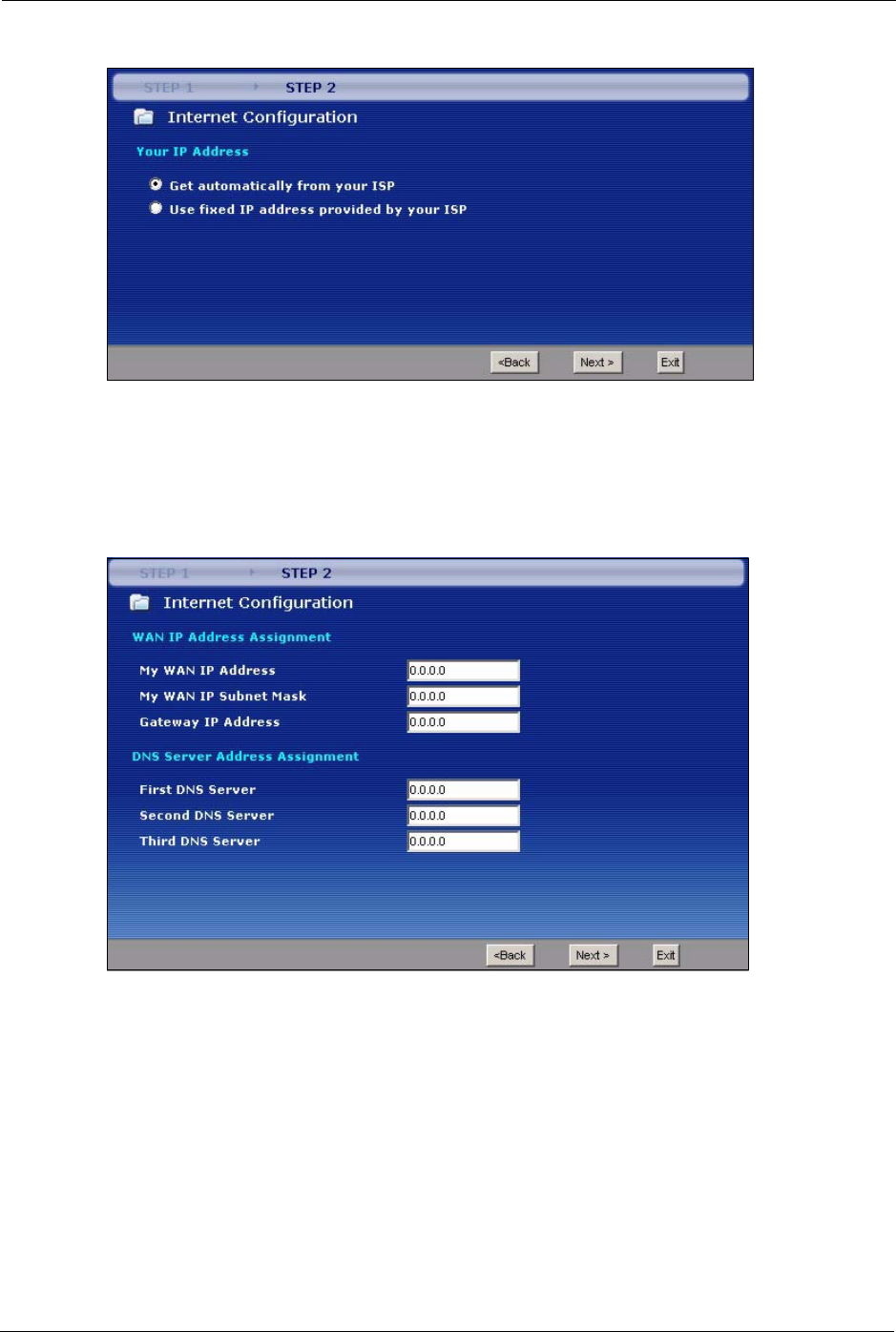
ZyXEL MAX-200M1 Series User’s Guide
52 Chapter 4 Internet Setup Wizard
Figure 21 The Connection Wizard: Your IP Address
8If you selected Get automatically from your ISP in the previous screen, skip this step. If
you selected Use fixed IP address provided by your ISP, the following screen appears.
Enter your IP address, subnet mask, gateway address and DNS details exactly as they
were given to you by your ISP.
Figure 22 The Connection Wizard: WAN IP Address Assignment
9Every network device has a unique, factory-assigned Media Access Control (MAC)
address. A device’s MAC address can be used to identify it over the network. In the
following screen, you can set the ZyXEL Device to transmit its own MAC address over
the Internet, or to use the MAC address of another device connected to the ZyXEL
Device (“spoofing”).
Leave Factory Default selected to have the ZyXEL Device use its own MAC address, or
select Spoof this computer’s MAC address to use another.
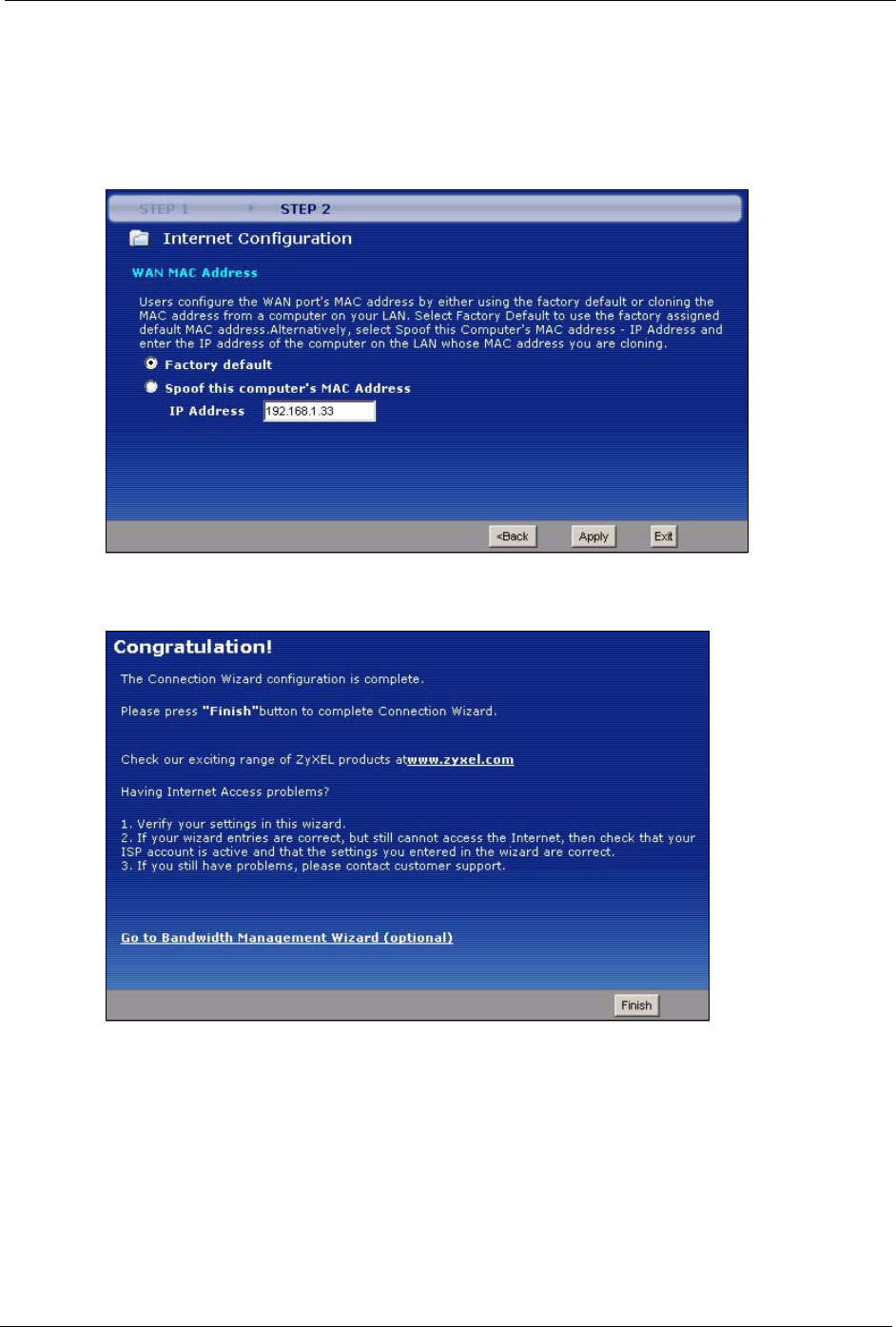
ZyXEL MAX-200M1 Series User’s Guide
Chapter 4 Internet Setup Wizard 53
The IP Address field contains the IP address of the computer you are using to configure
the ZyXEL Device by default. If you have multiple devices connected to the ZyXEL
Device, you can enter the IP address of another device on the LAN to have the ZyXEL
Device use its MAC address instead. Click Apply to move on to the final screen.
Figure 23 The Connection Wizard: WAN MAC Address
10Click Finish to complete and save the Connection Wizard settings.
Figure 24 The Connection Wizard: Congratulations
11Launch your web browser and navigate to www.zyxel.com. Internet access is just the
beginning. Refer to the rest of this guide for more detailed information on the complete
range of ZyXEL Device features. If you cannot access the Internet, open the web
configurator again to confirm that the Internet settings you configured in the wizard setup
are correct.

ZyXEL MAX-200M1 Series User’s Guide
54 Chapter 4 Internet Setup Wizard
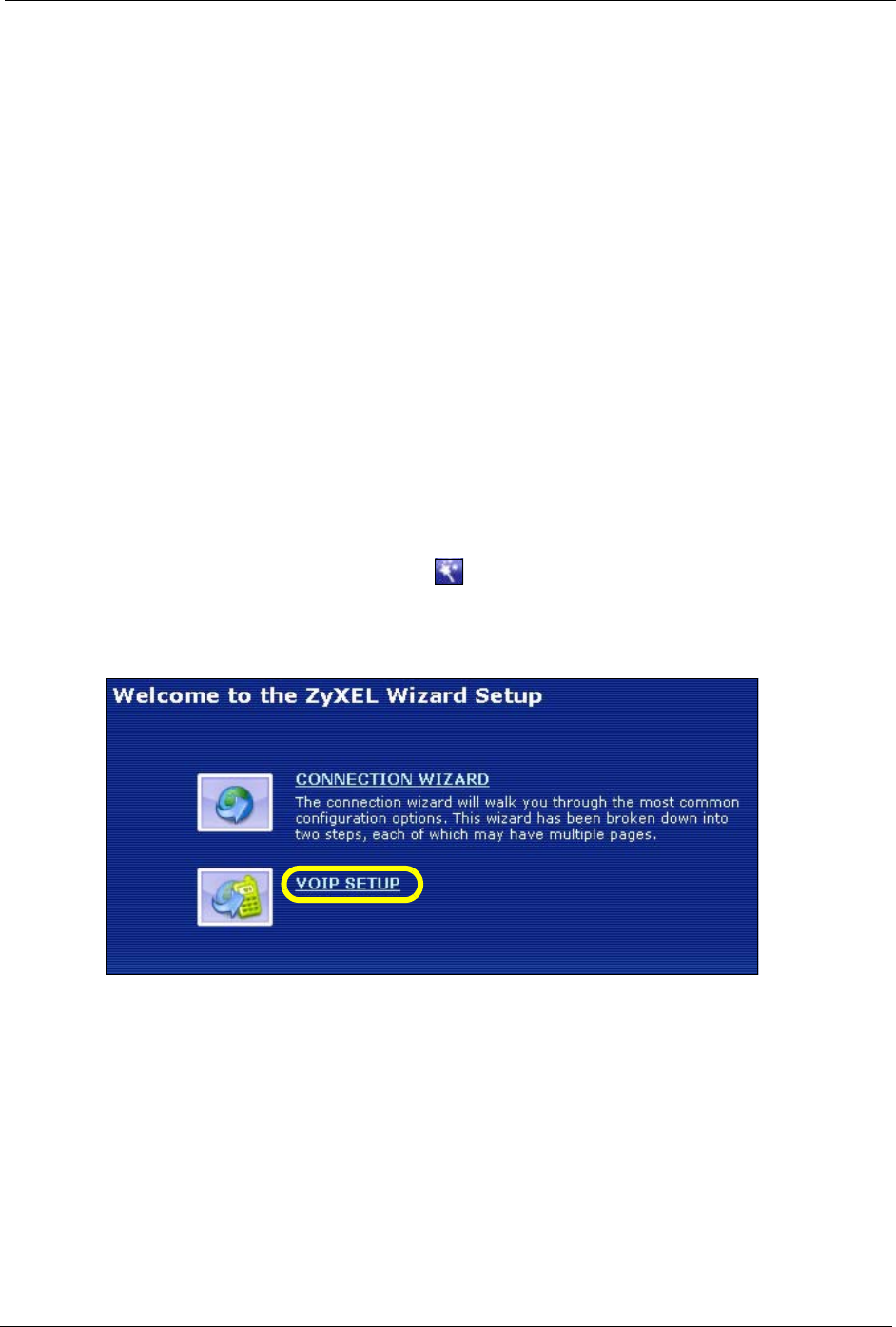
ZyXEL MAX-200M1 Series User’s Guide
Chapter 5 VoIP Wizard 55
CHAPTER 5
VoIP Wizard
This chapter shows you how to use the wizard to set up your SIP account(s).
5.1 Introduction
The ZyXEL Device has Voice over IP (VoIP) communication capabilities that allow you to use
a traditional analog telephone to make Internet calls. You can configure the ZyXEL Device to
use up to two SIP based VoIP accounts.
5.2 VOIP Wizard Setup
1After you enter the password to access the web configurator, select Go to Wizard setup.
Otherwise, click the wizard icon ( ) in the top right corner of the web configurator to
display the wizard main screen. Click VOIP SETUP to configure the system for Voice
Over Internet connection.
Figure 25 Select a Mode
2The following screen displays. This wizard screen allows you to configure your voice
settings for SIP account 1. Fill in the fields with information from your VoIP service
provider. Leave the default settings in fields for which no information was provided
(except if otherwise specified). See Chapter 10 on page 105 for background information
on these fields.
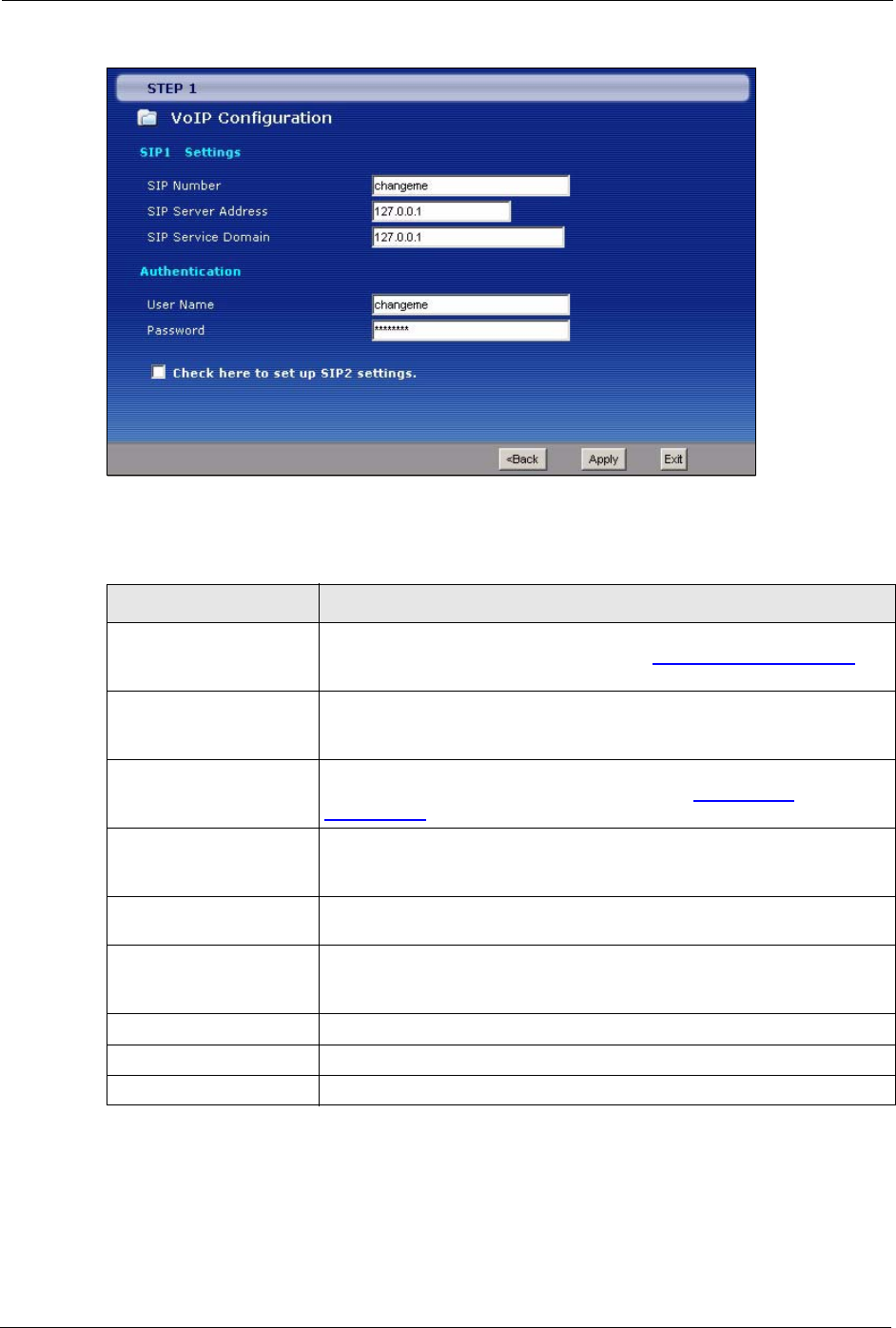
ZyXEL MAX-200M1 Series User’s Guide
56 Chapter 5 VoIP Wizard
Figure 26 VOIP Wizard: Configuration
The following table describes the labels in this screen
3The ZyXEL Device attempts to register your SIP account with the SIP server.
Table 5 VOIP Wizard Configuration
LABEL DESCRIPTION
SIP Number Enter your SIP number in this field (use the number or text that comes
before the @ symbol in a SIP account like 1234@VoIP-provider.com).
You can use up to 127 ASCII characters.
SIP Server Address Type the IP address or domain name of the SIP server in this field. It
doesn’t matter whether the SIP server is a proxy, redirect or register server.
You can use up to 95 ASCII characters.
SIP Service Domain Enter the SIP service domain name in this field (the domain name that
comes after the @ symbol in a SIP account like 1234@VoIP-
provider.com). You can use up to 127 ASCII Extended set characters.
User Name This is the user name for registering this SIP account with the SIP register
server. Type the user name exactly as it was given to you. You can use up
to 95 ASCII characters.
Password Type the password associated with the user name above. You can use up
to 95 ASCII Extended set characters.
Check here to set up SIP2
settings.
This screen configures SIP account 1. Select the check box if you have
a second SIP account that you want to use. You will need to configure the
same fields for the second SIP account.
Back Click Back to return to the previous screen.
Apply Click Apply to complete the wizard setup and save your configuration.
Exit Click Exit to close the wizard without saving your settings.
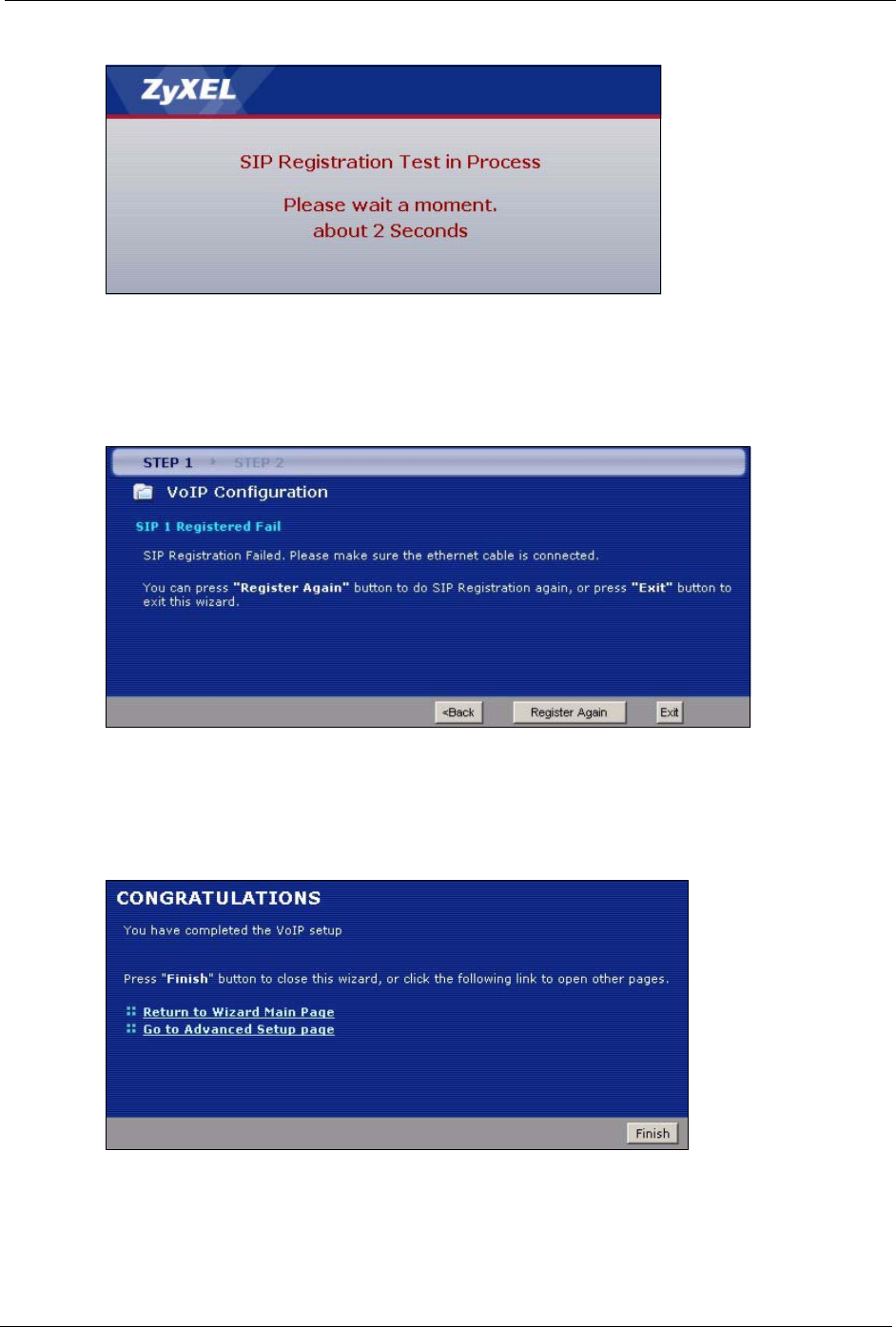
ZyXEL MAX-200M1 Series User’s Guide
Chapter 5 VoIP Wizard 57
Figure 27 VoIP Wizard: SIP Registration Test
4This screen displays if SIP account registration fails. Check your WiMAX connection
using the LINK and SIGNAL LEDs on the front of the ZyXEL Device. Then wait a few
seconds and click Register Again. If your Internet connection was already working, you
can click Back and try re-entering your SIP account settings.
Figure 28 VoIP Wizard: Fail
5This screen displays if your SIP account registration was successful. Click Return to
Wizard Main Page if you want to use another configuration wizard. Click Go to
Advanced Setup page or Finish to close the wizard and go to the main web configurator
screens.
Figure 29 VOIP Wizard: Finish

ZyXEL MAX-200M1 Series User’s Guide
58 Chapter 5 VoIP Wizard
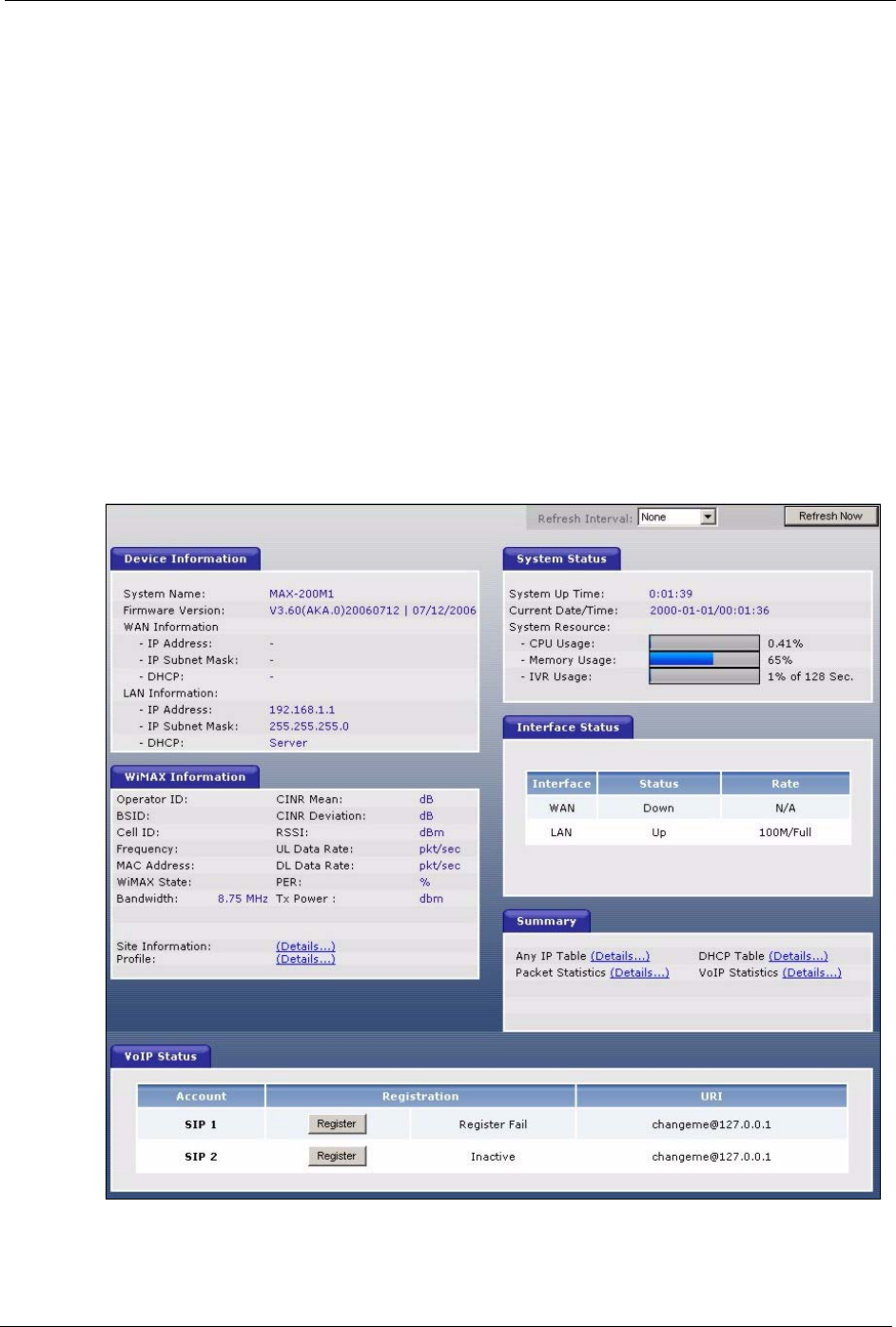
ZyXEL MAX-200M1 Series User’s Guide
Chapter 6 Status Screens 59
CHAPTER 6
Status Screens
Use the Status screens to look at the current status of the device, system resources, interfaces
(LAN and WAN), and SIP accounts. You can also register and unregister SIP accounts. The
Status screen also provides detailed information from Any IP and DHCP and statistics from
WiMAX, VoIP, bandwidth management, and traffic.
6.1 Status Screen
Click Status to open this screen.
Figure 30 Status Screen

ZyXEL MAX-200M1 Series User’s Guide
60 Chapter 6 Status Screens
Each field is described in the following table.
Table 6 Status Screen
LABEL DESCRIPTION
Refresh Interval Enter how often you want the ZyXEL Device to update this screen.
Refresh Now Click this to update this screen immediately.
Device Information
System Name This field displays the ZyXEL Device system name. It is used for identification. You
can change this in the Maintenance > System > General screen’s System Name
field.
Firmware
Version
This field displays the current version of the firmware inside the device. It also
shows the date the firmware version was created. You can change the firmware
version by uploading new firmware in Maintenance > Tools > Firmware.
WAN Information
IP Address This field displays the current IP address of the ZyXEL Device in the WAN.
IP Subnet
Mask
This field displays the current subnet mask on the WAN.
DHCP This field displays what DHCP services the ZyXEL Device is using in the WAN.
Choices are:
Client - The ZyXEL Device is a DHCP client in the WAN. Its IP address comes
from a DHCP server on the WAN.
None - The ZyXEL Device is not using any DHCP services in the WAN. It has a
static IP address.
If you are not using Roadrunner on Ethernet, you can change this in Network >
WAN. If you are using Roadrunner on Ethernet, this is controlled by Roadrunner.
LAN Information
IP Address This field displays the current IP address of the ZyXEL Device in the LAN.
IP Subnet
Mask
This field displays the current subnet mask in the LAN.
DHCP This field displays what DHCP services the ZyXEL Device is providing to the LAN.
Choices are:
Server - The ZyXEL Device is a DHCP server in the LAN. It assigns IP addresses
to other computers in the LAN.
Relay - The ZyXEL Device is routing DHCP requests to one or more DHCP
servers. The DHCP server(s) may be on another network.
None - The ZyXEL Device is not providing any DHCP services to the LAN.
You can change this in Network > LAN > DHCP Setup.
WiMAX
Information
Operator ID Every WiMAX service provider has a unique Operator ID number, which is
broadcast by each base station it owns. You can only connect to the Internet
through base stations belonging to your service provider’s network.
BSID This field displays the identification number of the wireless base station to which
the ZyXEL Device is connected. Every base station transmits a unique BSID,
which identifies it across the network.
Cell ID A base station’s coverage area can be divided into multiple cells. This field shows
the identification number of the cell in which the ZyXEL Device is connected.
Frequency This field displays the radio frequency of the ZyXEL Device’s wireless connection
to a base station.

ZyXEL MAX-200M1 Series User’s Guide
Chapter 6 Status Screens 61
MAC address This field displays the Media Access Control address of the ZyXEL Device. Every
network device has a unique MAC address which identifies it across the network.
WiMAX State This field displays the status of the ZyXEL Device’s current connection.
•NA: the ZyXEL Device is starting up.
•Fail: The ZyXEL Device is unable to connect to a base station.
•Initial Synchronization: the ZyXEL Device is attempting to locate a base
station.
•Initial DCD (Downlink Channel Descriptor): the ZyXEL Device has located a
base station and is receiving information about a possible downlink connection.
•Initial UCD (Uplink Channel Descriptor): the ZyXEL Device is receiving
information from the base station about a possible uplink connection.
• Initial Ranging and Calibration: the ZyXEL Device and the base station are
transmitting and receiving information about the distance between them.
Ranging allows the ZyXEL Device to use a lower transmission power level
when communicating with a nearby base station, and a higher transmission
power level when communicating with a distant base station.
•Initial Negotiation: the ZyXEL Device and the base station are exchanging
information about their capabilities.
•Initial PKM (Privacy Key Management): the ZyXEL Device and the base
station are exchanging security information.
•Initial Registration: the ZyXEL Device is registering with a RADIUS server.
•Running: the ZyXEL Device has successfully registered with the base station.
Traffic can now flow between the ZyXEL Device and the base station.
•Sleep: the ZyXEL Device is in power saving mode, but periodically checks
whether a base station has traffic waiting.
•Idle: the ZyXEL Device is in power saving mode, but can connect when a base
station alerts it that there is traffic waiting.
•Handover: the ZyXEL Device is moving from one coverage area to another,
and is connecting to the new base station.
Bandwidth This field shows the size of the bandwidth step the ZyXEL Device uses to connect
to a base station in megahertz (MHz).
CINR mean This field shows the average Carrier to Interference plus Noise Ratio of the current
connection. This value is an indication of overall radio signal quality. A higher value
indicates a higher signal quality, and a lower value indicates a lower signal quality.
CINR deviation This field shows the amount of change in the CINR level. This value is an
indication of radio signal stability. A lower number indicates a more stable signal,
and a higher number indicates a less stable signal.
RSSI This field shows the Received Signal Strength Indication. This value is a
measurement of overall radio signal strength. A higher RSSI level indicates a
stronger signal, and a lower RSSI level indicates a weaker signal.
UL Data Rate This field shows the number of data packets uploaded from the ZyXEL Device to
the base station each second.
DL Data Rate This field shows the number of data packets downloaded to the ZyXEL Device
from the base station each second.
PER This field shows the Packet Error Rate. The PER is the percentage of data packets
transmitted across the network but not successfully received.
Tx Power This field shows the output transmission (Tx) level of the ZyXEL Device.
Site
Information
Click this link to view details of the radio frequencies used by the ZyXEL Device to
connect to a base station.
Profile Click this link to view details of the current wireless security settings.
Table 6 Status Screen
LABEL DESCRIPTION

ZyXEL MAX-200M1 Series User’s Guide
62 Chapter 6 Status Screens
System Status
System Up
Time
This field displays how long the ZyXEL Device has been running since it last
started up. The ZyXEL Device starts up when you plug it in, when you restart it
(Maintenance > Tools > Restart), or when you reset it (see Section 2.1.2 on page
35).
Current Date/
Time
This field displays the current date and time in the ZyXEL Device. You can change
this in Maintenance > System > Time Setting.
CPU Usage This field displays what percentage of the ZyXEL Device’s processing ability is
currently being used. The higher the CPU usage, the more likely the ZyXEL Device
is to slow down. You can reduce this by disabling some services, such as DHCP,
NAT, or content filtering.
Memory
Usage
This field displays what percentage of the ZyXEL Device’s memory is currently
used. The higher the memory usage, the more likely the ZyXEL Device is to slow
down. Some memory is required just to start the ZyXEL Device and to run the web
configurator. You can reduce the memory usage by disabling some services (see
CPU Usage); by reducing the amount of memory allocated to NAT and firewall
rules (you may have to reduce the number of NAT rules or firewall rules to do so);
or by deleting rules in functions such as incoming call policies, speed dial entries,
and static routes.
IVR Usage This field displays what percentage of the ZyXEL Device’s IVR memory is currently
used. IVR (Interactive Voice Response) refers to the customizable ring tone and
on-hold music you set. See Section 10.1.11 on page 111 for more information.
Interface Status
Interface This column displays each interface of the ZyXEL Device.
Status This field indicates whether or not the ZyXEL Device is using the interface.
For the WAN interface, this field displays Up when the ZyXEL Device is connected
to a WiMAX network, and Down when the ZyXEL Device is not connected to a
WiMAX network.
For the LAN interface, this field displays Up when the ZyXEL Device is using the
interface and Down when the ZyXEL Device is not using the interface.
Rate For the LAN ports this displays the port speed and duplex setting.
For the WAN interface, it displays the downstream and upstream transmission rate
or N/A if the ZyXEL Device is not connected to a base station.
Summary
Any IP Table Click this link to view a list of IP addresses and MAC addresses of computers
connected to the ZyXEL Device but not in the same subnet.
Packet
Statistics
Click this link to view port status and packet specific statistics.
DHCP Table Click this link to see details of computers to which the ZyXEL Device has given an
IP address.
VoIP Statistics Click this link to view statistics about your VoIP usage.
VoIP Status
Account This column displays each SIP account in the ZyXEL Device.
Table 6 Status Screen
LABEL DESCRIPTION

ZyXEL MAX-200M1 Series User’s Guide
Chapter 6 Status Screens 63
6.2 Site Information
Click Status > Site Information to view this screen. This read-only screen shows information
about the ZyXEL Device’s connection with a WiMAX base station. To configure these
settings, go to the Network > WAN > WiMAX Frequency screen.
Registration This field displays the current registration status of the SIP account. You have to
register SIP accounts with a SIP server to use VoIP.
If the SIP account is already registered with the SIP server,
Click Unregister to delete the SIP account’s registration in the SIP server. This
does not cancel your SIP account, but it deletes the mapping between your SIP
identity and your IP address or domain name.
The second field displays Registered.
If the SIP account is not registered with the SIP server,
Click Register to have the ZyXEL Device attempt to register the SIP account with
the SIP server.
The second field displays the reason the account is not registered.
Inactive - The SIP account is not active. You can activate it in VoIP > SIP > SIP
Settings.
Register Fail - The last time the ZyXEL Device tried to register the SIP account
with the SIP server, the attempt failed. The ZyXEL Device automatically tries to
register the SIP account when you turn on the ZyXEL Device or when you activate
it.
URI This field displays the account number and service domain of the SIP account. You
can change these in VoIP > SIP > SIP Settings.
Table 6 Status Screen
LABEL DESCRIPTION
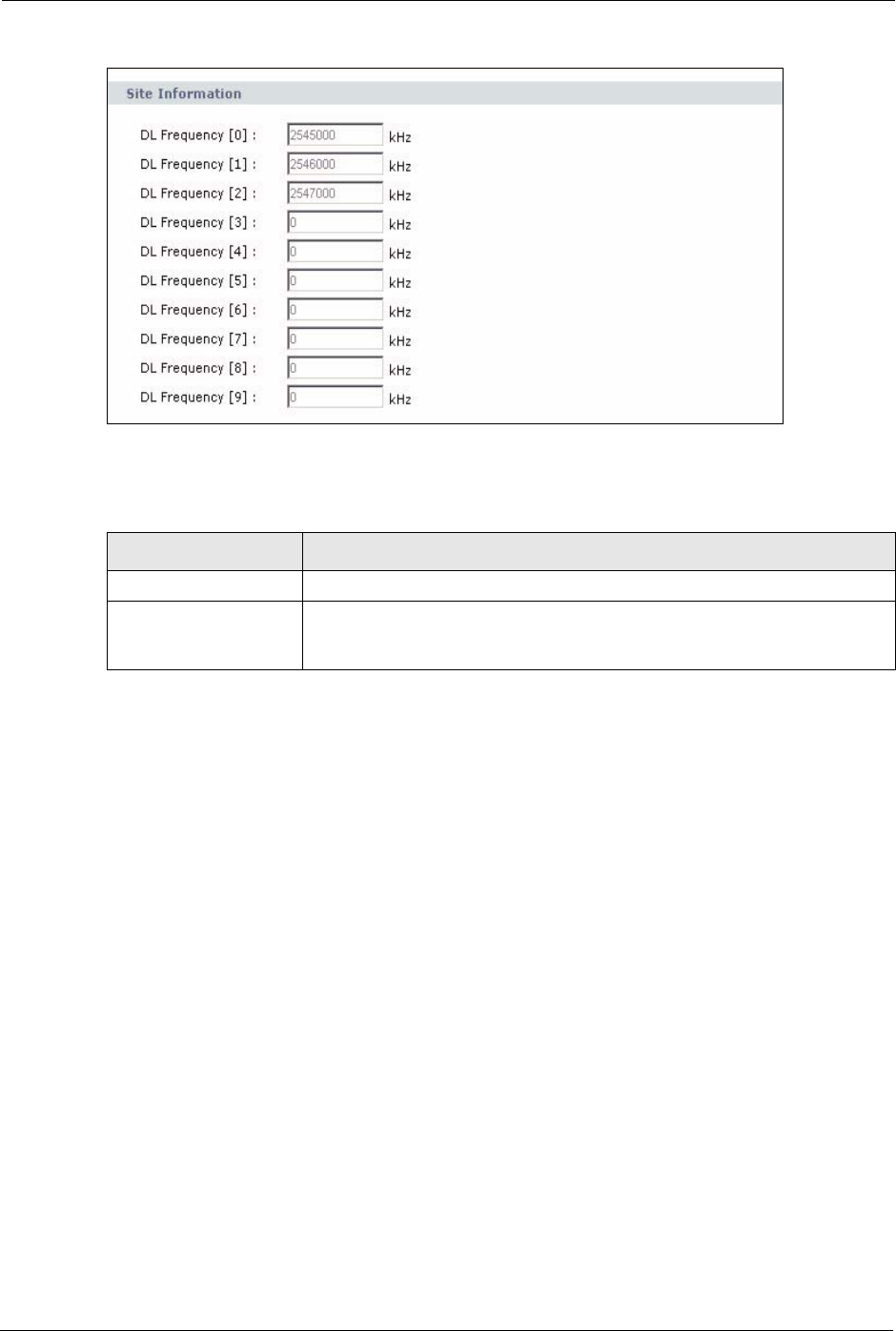
ZyXEL MAX-200M1 Series User’s Guide
64 Chapter 6 Status Screens
Figure 31 The Site Information Screen
The following table describes the labels in this screen.
6.3 Profile
Click Status > Profile to view this screen. This read-only screen displays information about
the security settings you are using. To configure these settings, go to the Network > WAN >
Internet Connection screen.
Table 7 The Site Information Screen
LABEL DESCRIPTION
Site Information
DL Frequency
[0] ~ [9]
These fields show the downlink frequency settings in kilohertz (kHz). These
settings determine how the ZyXEL Device searches for an available wireless
connection. See Section 7.4 on page 74 for more information.
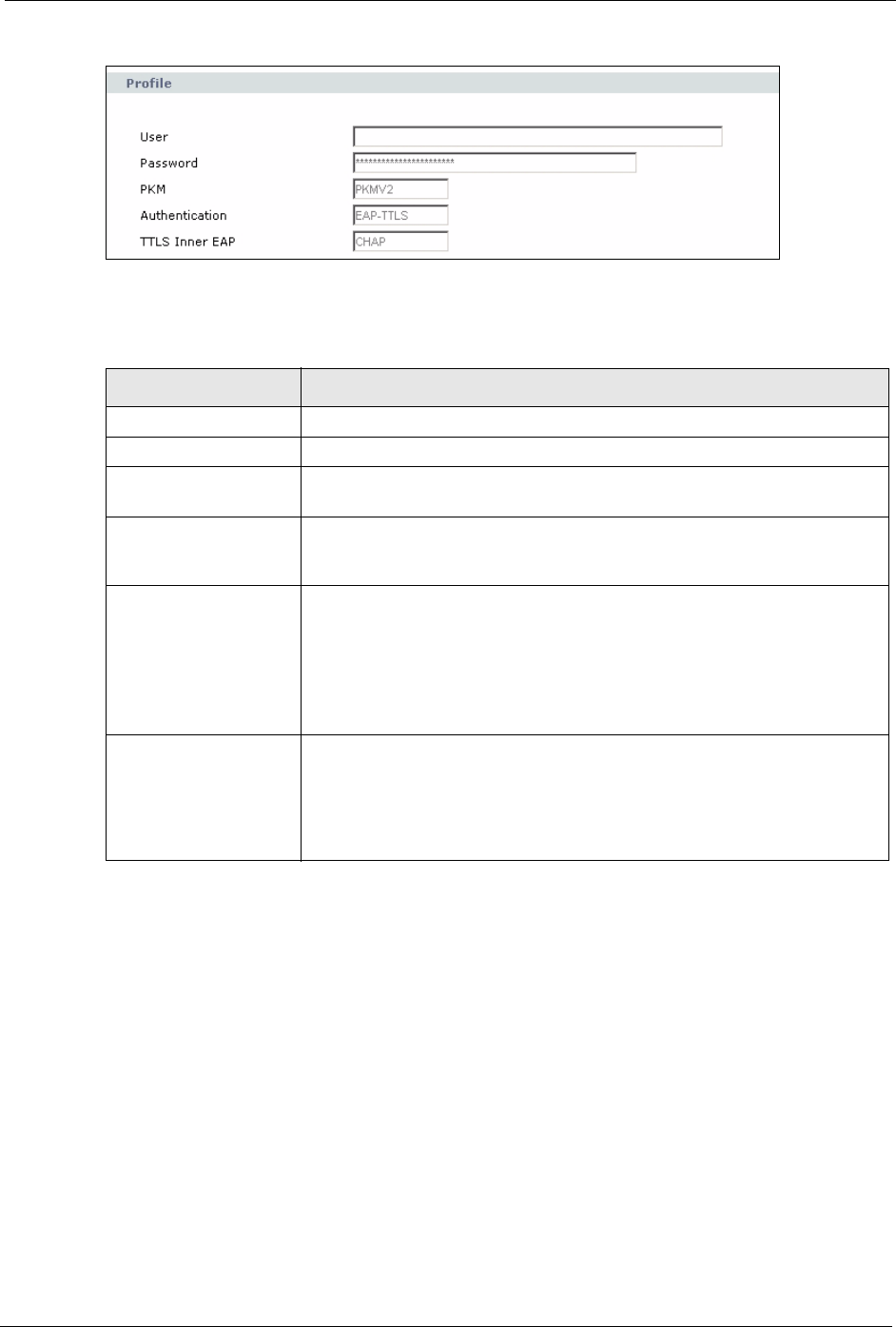
ZyXEL MAX-200M1 Series User’s Guide
Chapter 6 Status Screens 65
Figure 32 The WiMAX Profile Screen
The following table describes the labels in this screen.
6.4 Any IP Table Window
This screen displays the IP address of each computer that is using the ZyXEL Device via the
any IP feature. Any IP allows computers to access the Internet through the ZyXEL Device
without changing their network settings when NAT is enabled. To access this screen, open the
Status screen (see Section 6.1 on page 59), and click (Details...) next to Any IP Table.
Table 8 The WiMAX Profile Screen
LABEL DESCRIPTION
Profile
User This is the username for your Internet access account.
Password This is the password for your Internet access account. The password
displays as a row of asterisks.
PKM This field displays the Privacy Key Management version number. PKM
provides security between the ZyXEL Device and the base station. See the
WiMAX security appendix for more information.
Authentication This field displays the user authentication method. Authentication is the
process of confirming the identity of a user (by means of a username and
password, for example).
EAP-TTLS allows an MS/SS and a base station to establish a secure link (or
‘tunnel’) with an AAA (Authentication, Authorization and Accounting) server
in order to exchange authentication information. See the WiMAX security
appendix for more details.
TTLS Inner EAP This field displays the type of secondary authentication method. Once a
secure EAP-TTLS connection is established, the inner EAP is the protocol
used to exchange security information between the mobile station, the base
station and the AAA server to authenticate the mobile station. At the time of
writing, the ZyXEL Device supports only CHAP (Challenge Handshake
Authentication Protocol). See the WiMAX security appendix for more details.
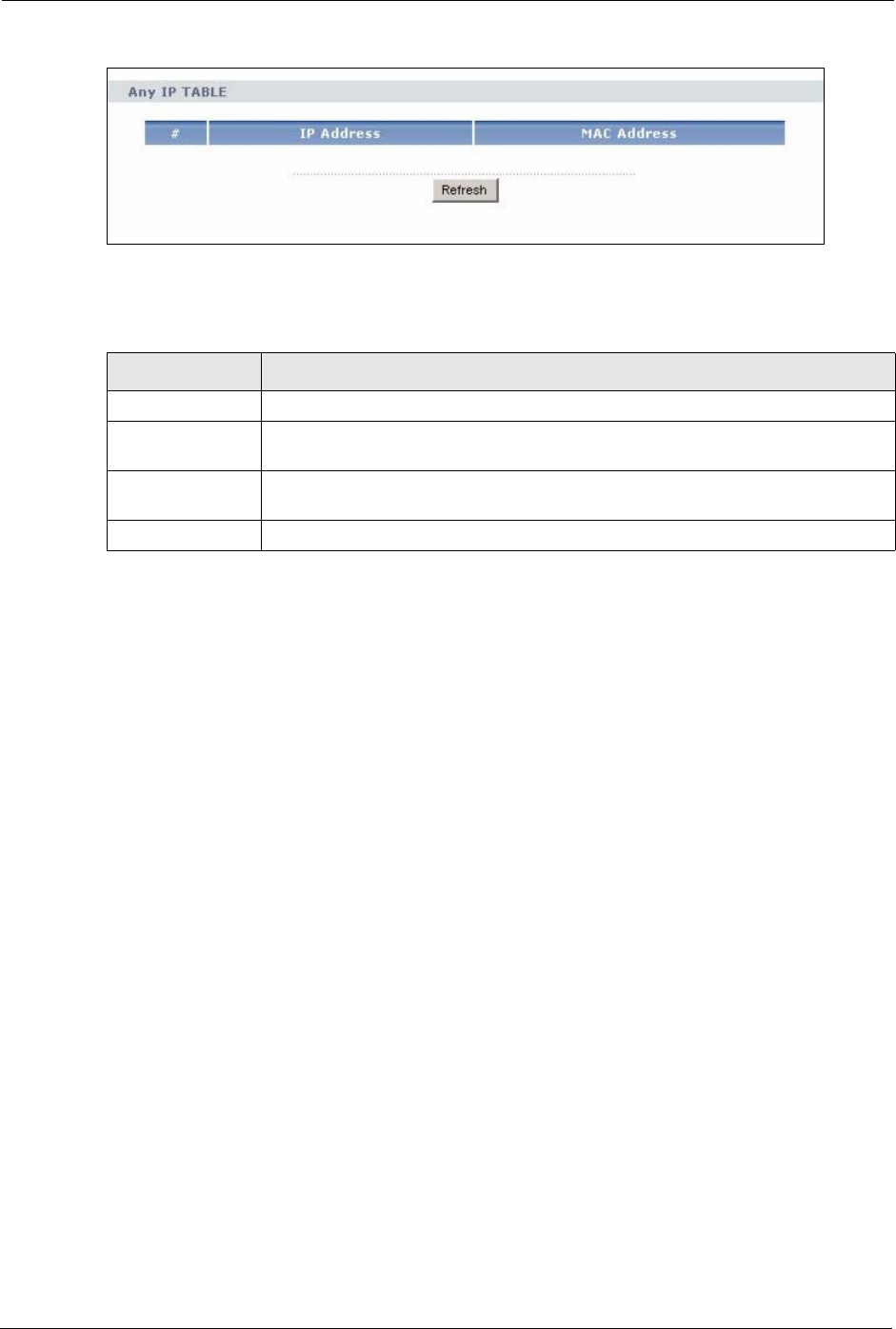
ZyXEL MAX-200M1 Series User’s Guide
66 Chapter 6 Status Screens
Figure 33 Any IP Table
Each field is described in the following table.
6.5 Packet Statistics
To access this screen, open the Status screen (see Section 6.1 on page 59), and click
(Details...) next to Packet Statistics. Read-only information here includes port status and
packet specific statistics. Also provided are "system up time" and "poll interval(s)". The Poll
Interval(s) field is configurable.
Table 9 Any IP Table
LABEL DESCRIPTION
# This field is a sequential value. It is not associated with a specific entry.
IP Address This field displays the IP address of each computer that is using the ZyXEL Device
but is in a different subnet than the ZyXEL Device.
MAC Address This field displays the MAC address of the computer that is using the ZyXEL
Device but is in a different subnet than the ZyXEL Device.
Refresh Click this to update this screen.
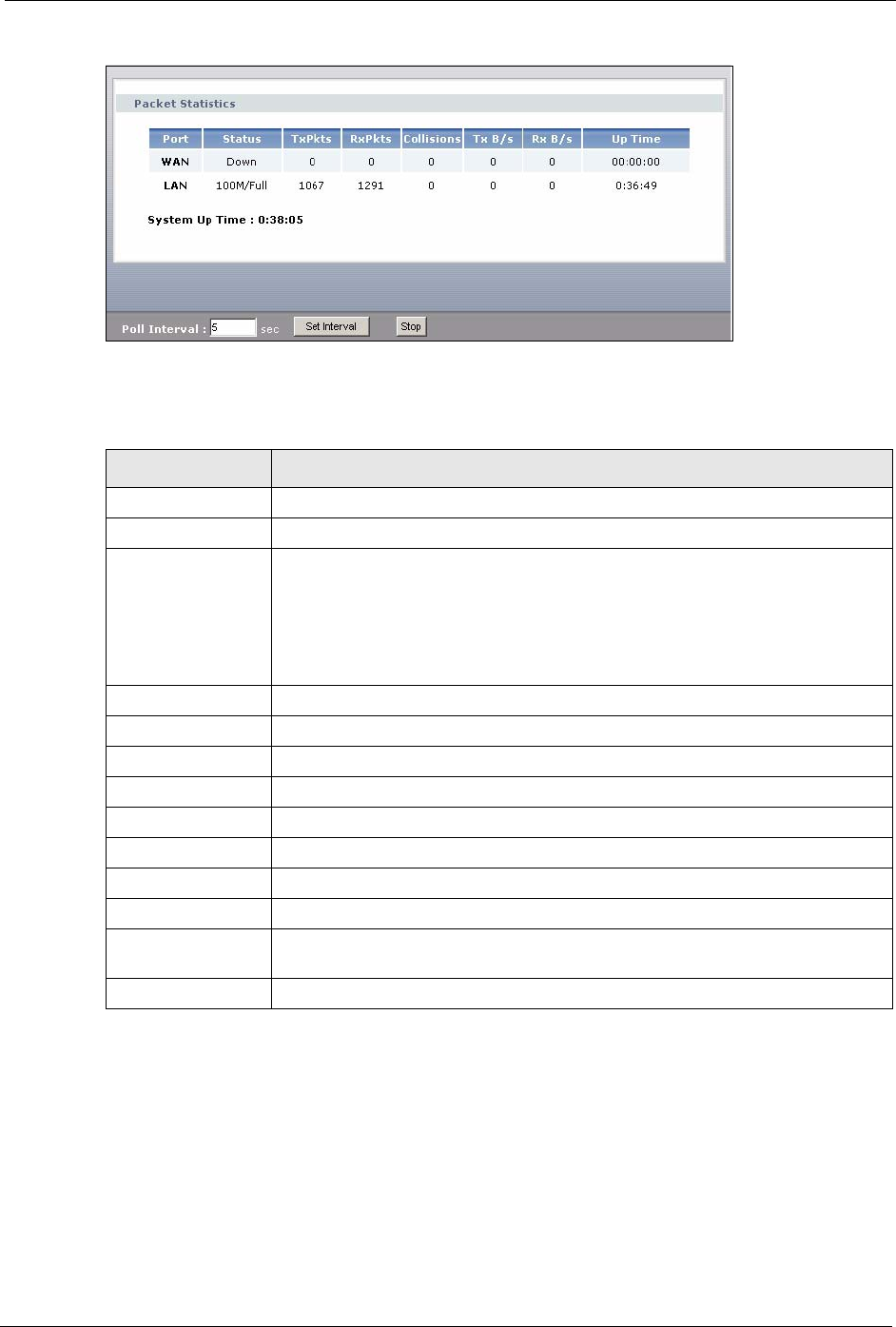
ZyXEL MAX-200M1 Series User’s Guide
Chapter 6 Status Screens 67
Figure 34 Packet Statistics
The following table describes the fields in this screen.
6.6 DHCP Table Screen
This screen displays information about computers that received an IP address from the ZyXEL
Device. To access this screen, open the Status screen (see Section 6.1 on page 59), and click
(Details...) next to DHCP Table.
Table 10 Packet Statistics
LABEL DESCRIPTION
Packet Statistics
Port This column displays each interface of the ZyXEL Device.
Status This field indicates whether or not the ZyXEL Device is using the interface.
For the WAN interface, this field displays Up when the ZyXEL Device is
connected to a WiMAX network, and Down when the ZyXEL Device is not
connected to a WiMAX network.
For the LAN interface, this field displays Up when the ZyXEL Device is using the
interface and Down when the ZyXEL Device is not using the interface.
TxPkts This field displays the number of packets transmitted on this interface.
RxPkts This field displays the number of packets received on this interface.
Collisions This field displays the number of collisions on this port.
Tx B/s This field displays the number of bytes transmitted in the last second.
Rx B/s This field displays the number of bytes received in the last second.
Up Time This field displays the elapsed time this interface has been connected.
System up Time This is the elapsed time the system has been on.
Poll Interval(s) Type the time interval for the browser to refresh system statistics.
Set Interval Click this button to apply the new poll interval you entered in the Poll Interval
field above.
Stop Click this button to halt the refreshing of the system statistics.
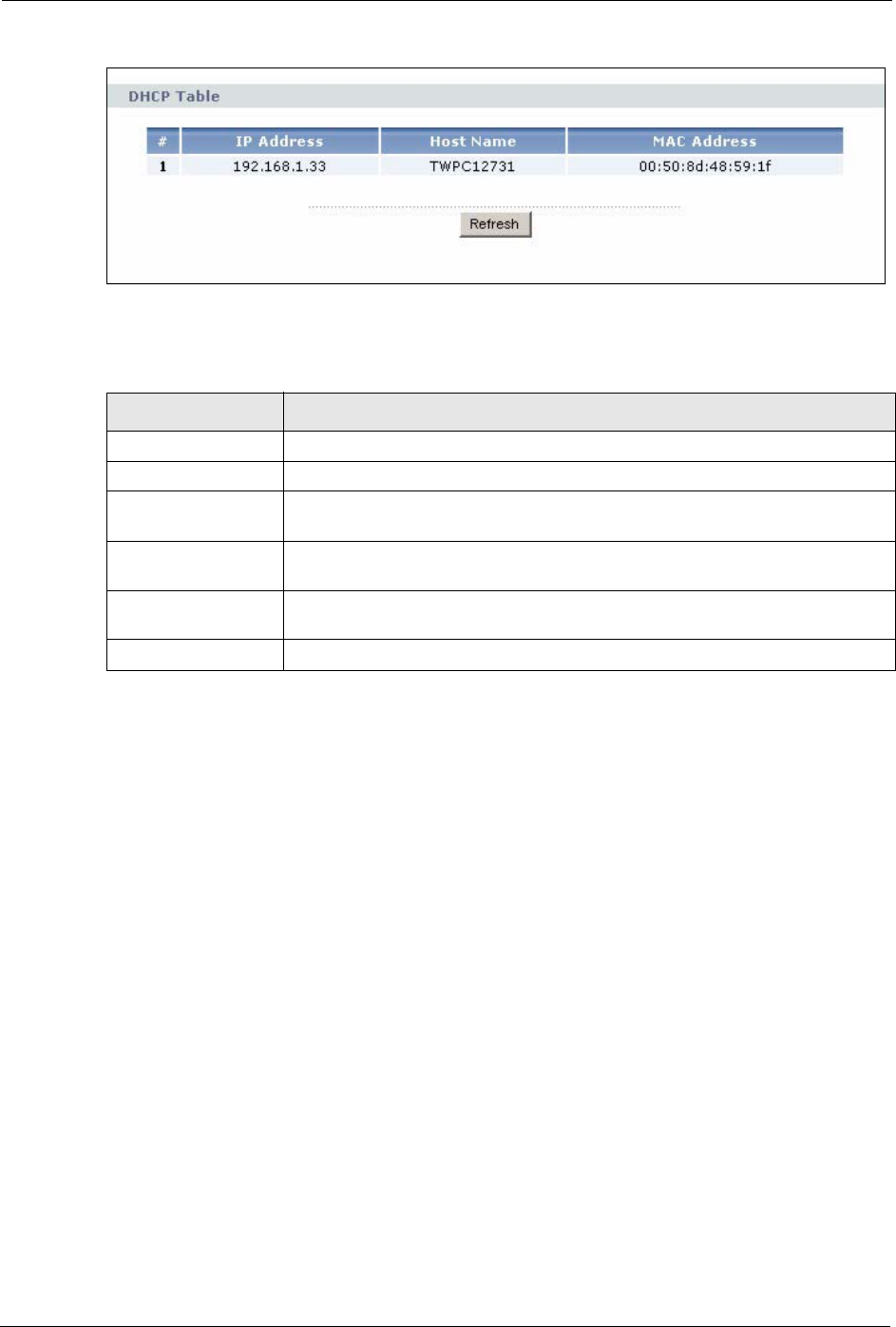
ZyXEL MAX-200M1 Series User’s Guide
68 Chapter 6 Status Screens
Figure 35 DHCP Table
Each field is described in the following table.
6.7 VoIP Statistics Window
This screen displays SIP registration information, status of calls and VoIP traffic statistics. To
access this screen, open the Status screen (see Section 6.1 on page 59), and click (Details...)
next to VoIP Statistics.
Table 11 DHCP Table
LABEL DESCRIPTION
DHCP Table
# This field is a sequential value. It is not associated with a specific entry.
IP Address This field displays the IP address the ZyXEL Device assigned to a computer in
the network.
Host Name This field displays the system name of the computer to which the ZyXEL Device
assigned the IP address.
MAC Address This field displays the MAC address of the computer to which the ZyXEL Device
assigned the IP address.
Refresh Click this to update this screen.
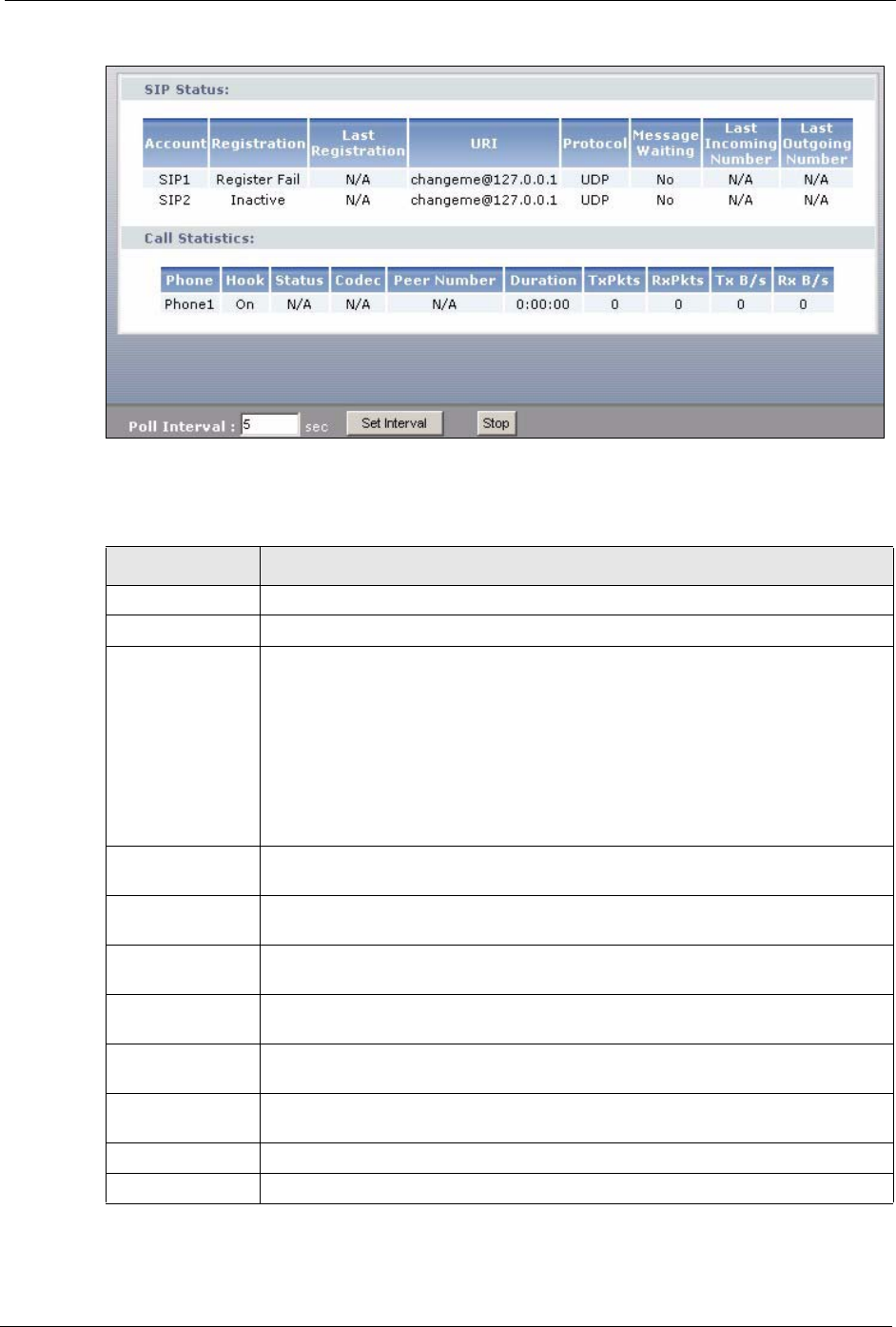
ZyXEL MAX-200M1 Series User’s Guide
Chapter 6 Status Screens 69
Figure 36 VoIP Statistics
Each field is described in the following table.
Table 12 VoIP Statistics
LABEL DESCRIPTION
SIP Status
Account This column displays each SIP account in the ZyXEL Device.
Registration This field displays the current registration status of the SIP account. You can
change this in the Status screen.
Registered - The SIP account is registered with a SIP server.
Register Fail - The last time the ZyXEL Device tried to register the SIP account
with the SIP server, the attempt failed. The ZyXEL Device automatically tries to
register the SIP account when you turn on the ZyXEL Device or when you activate
it.
Inactive - The SIP account is not active. You can activate it in VoIP > SIP > SIP
Settings.
Last Registration This field displays the last time you successfully registered the SIP account. It
displays N/A if you never successfully registered this account.
URI This field displays the account number and service domain of the SIP account. You
can change these in VoIP > SIP > SIP Settings.
Protocol This field displays the transport protocol the SIP account uses. SIP accounts
always use UDP.
Message Waiting This field indicates whether or not there are any messages waiting for the SIP
account.
Last Incoming
Number
This field displays the last number that called the SIP account. It displays N/A if no
number has ever dialed the SIP account.
Last Outgoing
Number
This field displays the last number the SIP account called. It displays N/A if the SIP
account has never dialed a number.
Call Statistics
Phone This field displays the ZyXEL Device’s phone port number.

ZyXEL MAX-200M1 Series User’s Guide
70 Chapter 6 Status Screens
Hook This field indicates whether the phone is on the hook or off the hook.
On - The phone is hanging up or already hung up.
Off - The phone is dialing, calling, or connected.
Status This field displays the current state of the phone call.
N/A - There are no current VoIP calls, incoming calls or outgoing calls being made.
DIAL - The callee’s phone is ringing.
RING - The phone is ringing for an incoming VoIP call.
Process - There is a VoIP call in progress.
DISC - The callee’s line is busy, the callee hung up or your phone was left off the
hook.
Codec This field displays what voice codec is being used for a current VoIP call through a
phone port.
Peer Number This field displays the SIP number of the party that is currently engaged in a VoIP
call through a phone port.
Duration This field displays how long the current call has lasted.
Tx Pkts This field displays the number of packets the ZyXEL Device has transmitted in the
current call.
Rx Pkts This field displays the number of packets the ZyXEL Device has received in the
current call.
Tx B/s This field displays how quickly the ZyXEL Device has transmitted packets in the
current call. The rate is the average number of bytes transmitted per second.
Rx B/s This field displays how quickly the ZyXEL Device has received packets in the
current call. The rate is the average number of bytes transmitted per second.
Poll Interval(s) Enter how often you want the ZyXEL Device to update this screen, and click Set
Interval.
Set Interval Click this to make the ZyXEL Device update the screen based on the amount of
time you specified in Poll Interval.
Stop Click this to make the ZyXEL Device stop updating the screen.
Table 12 VoIP Statistics
LABEL DESCRIPTION